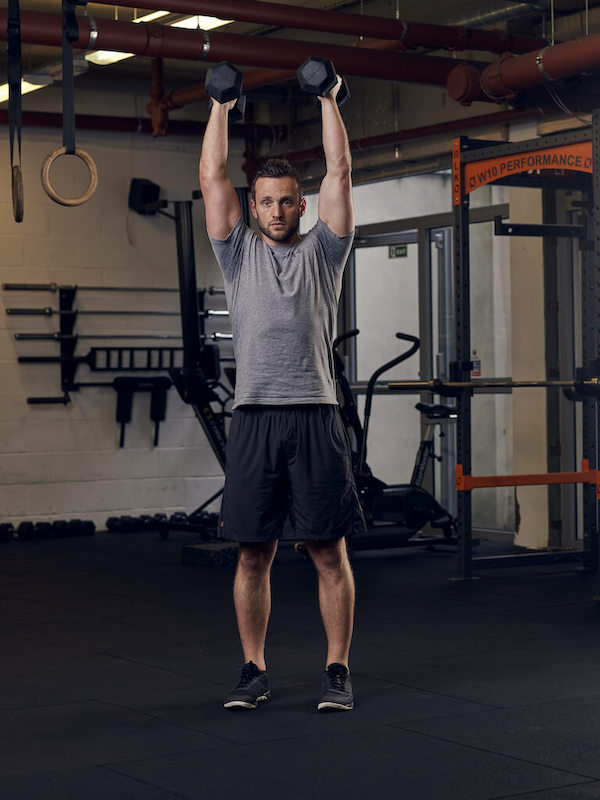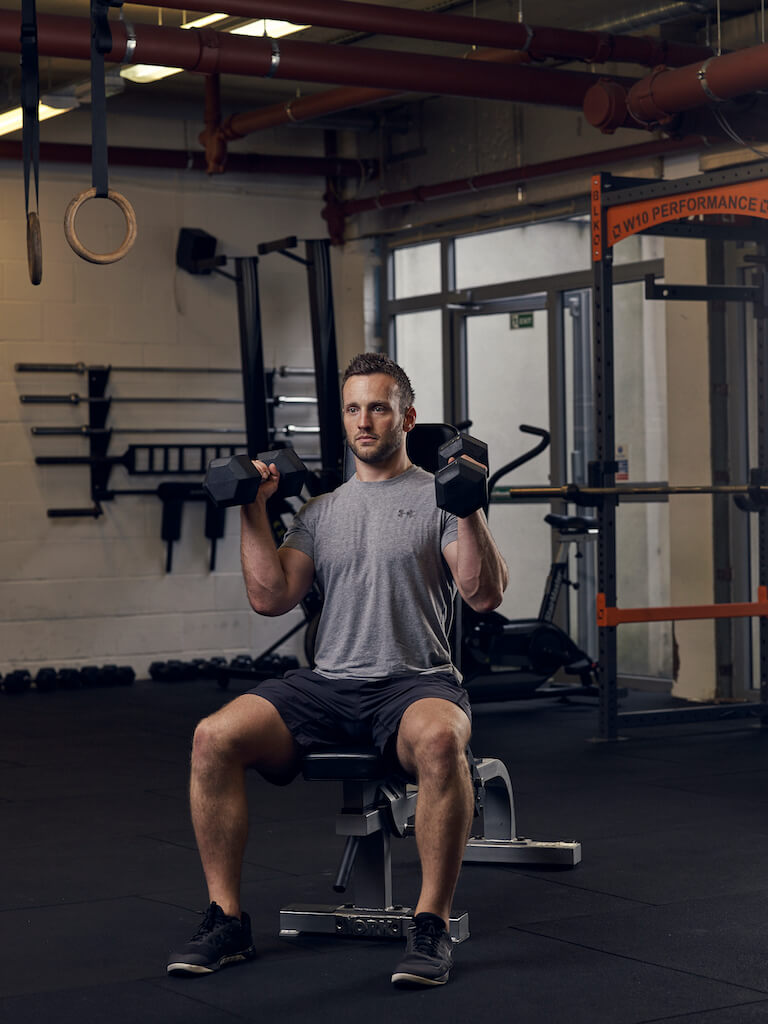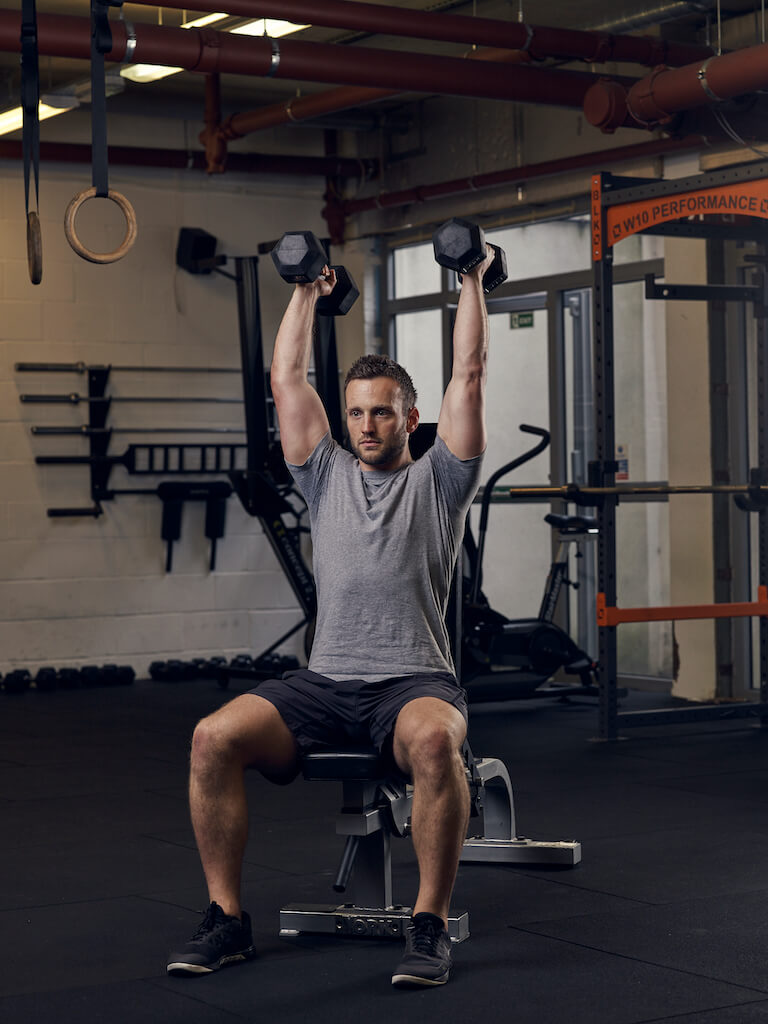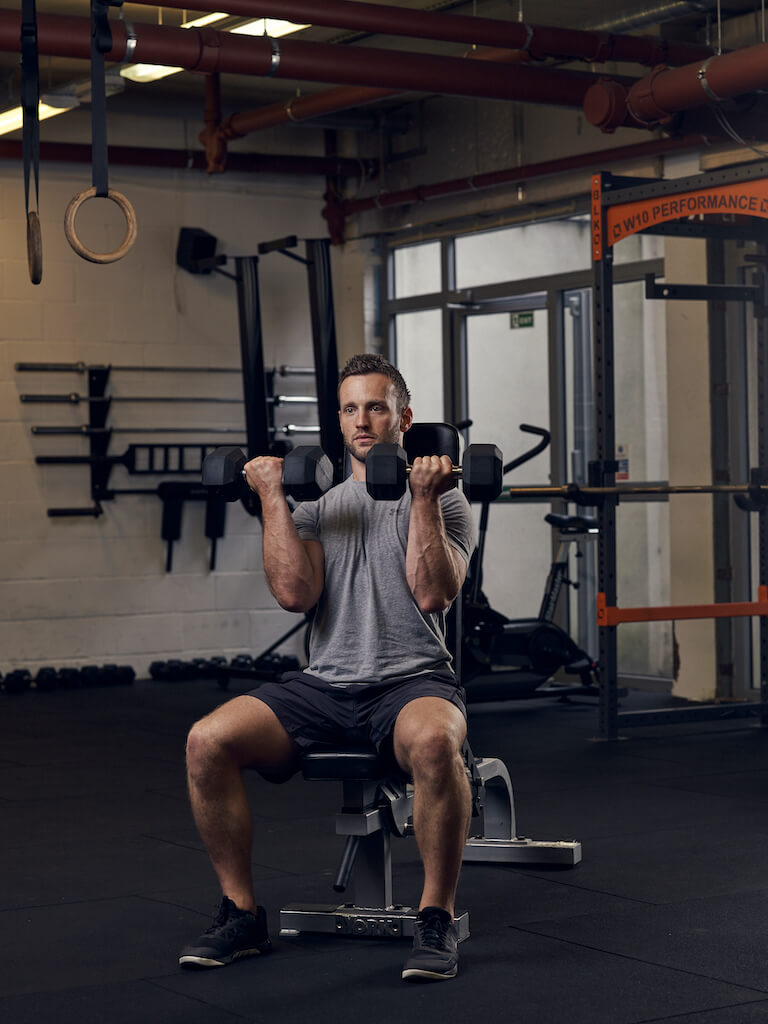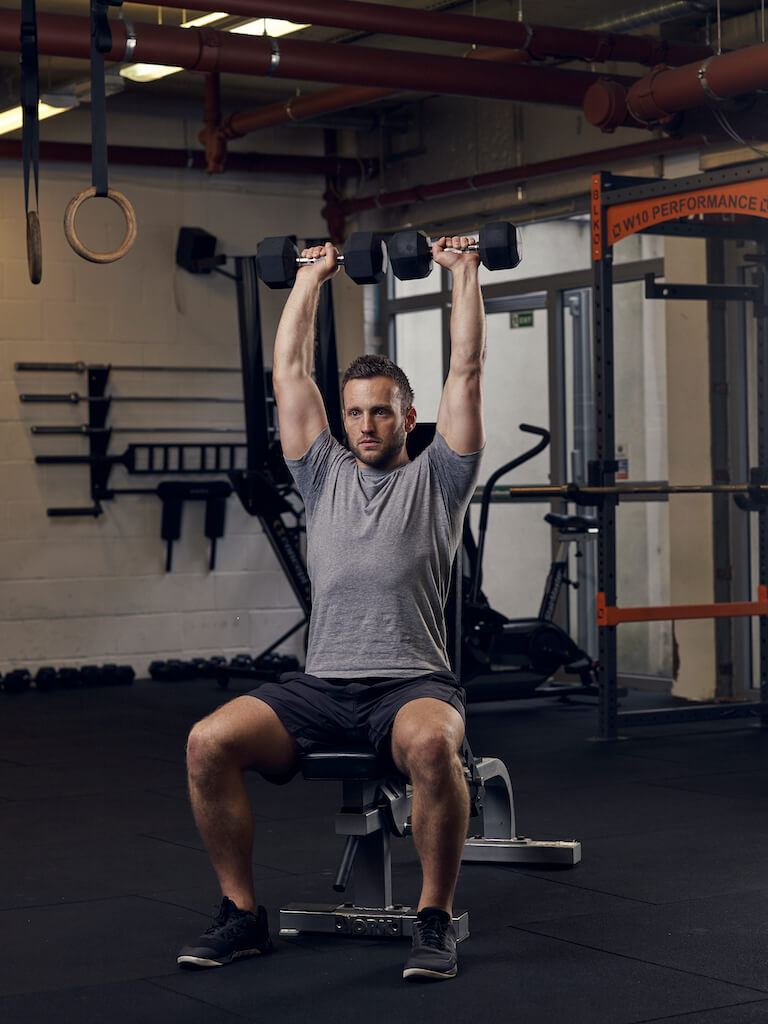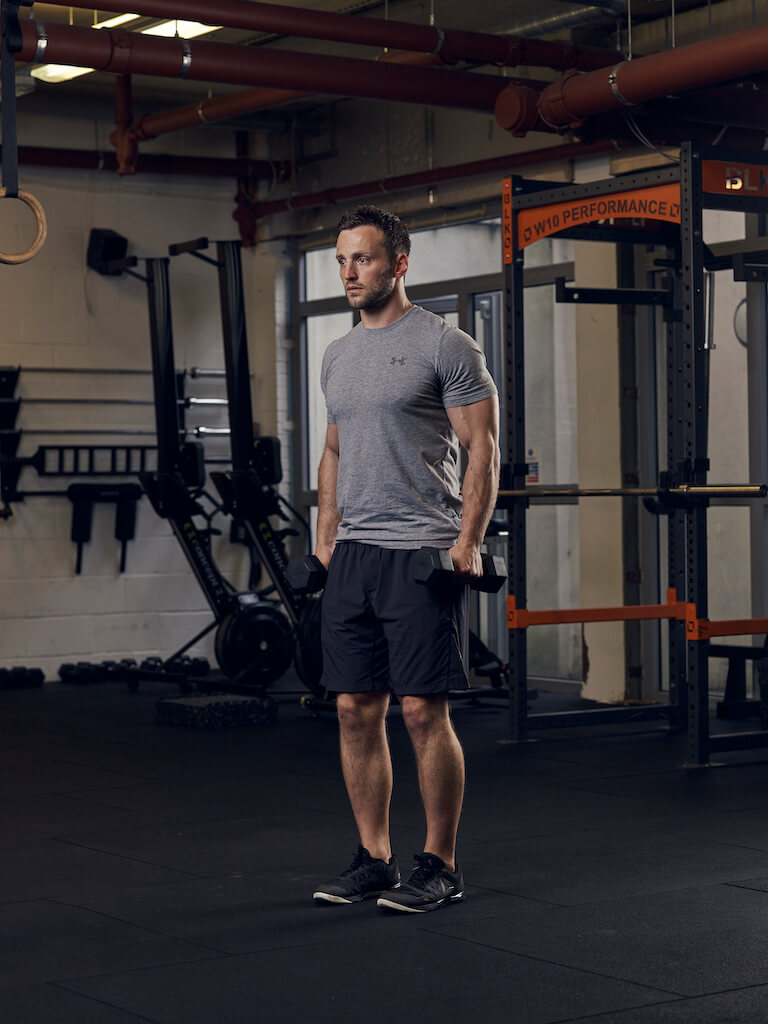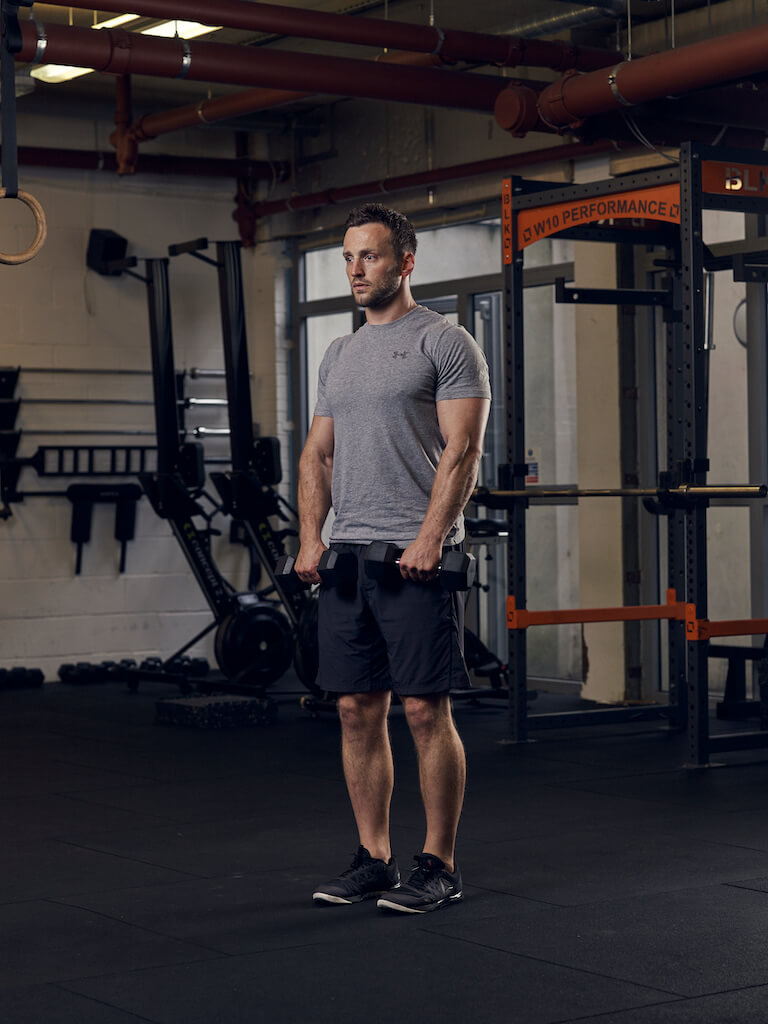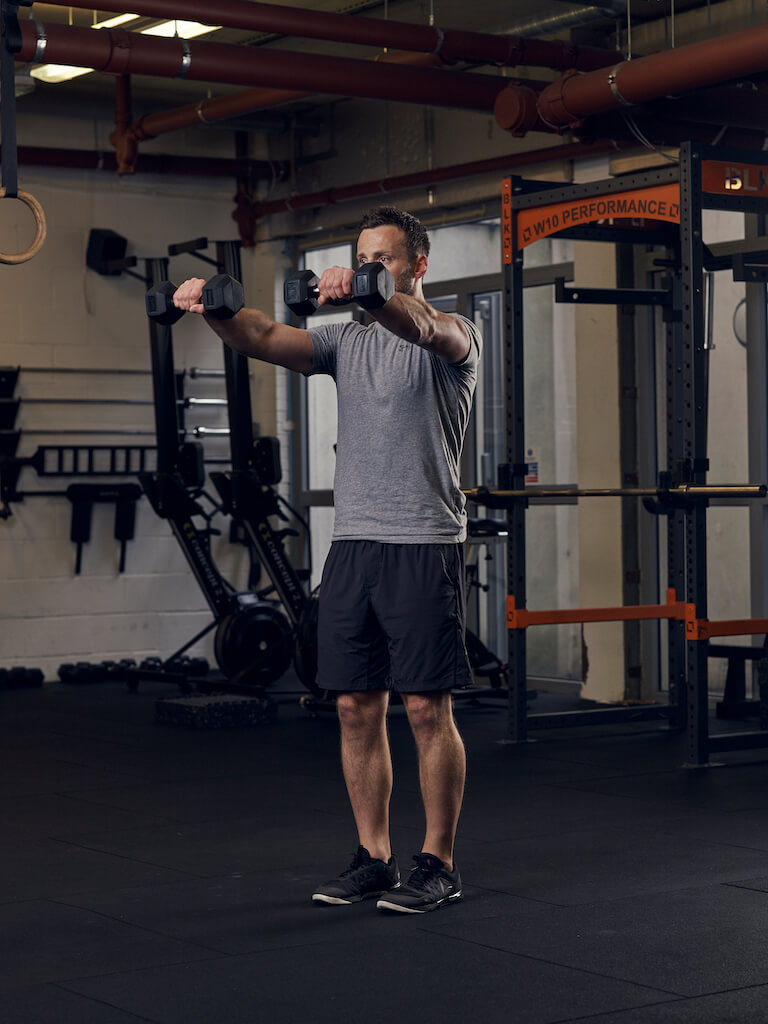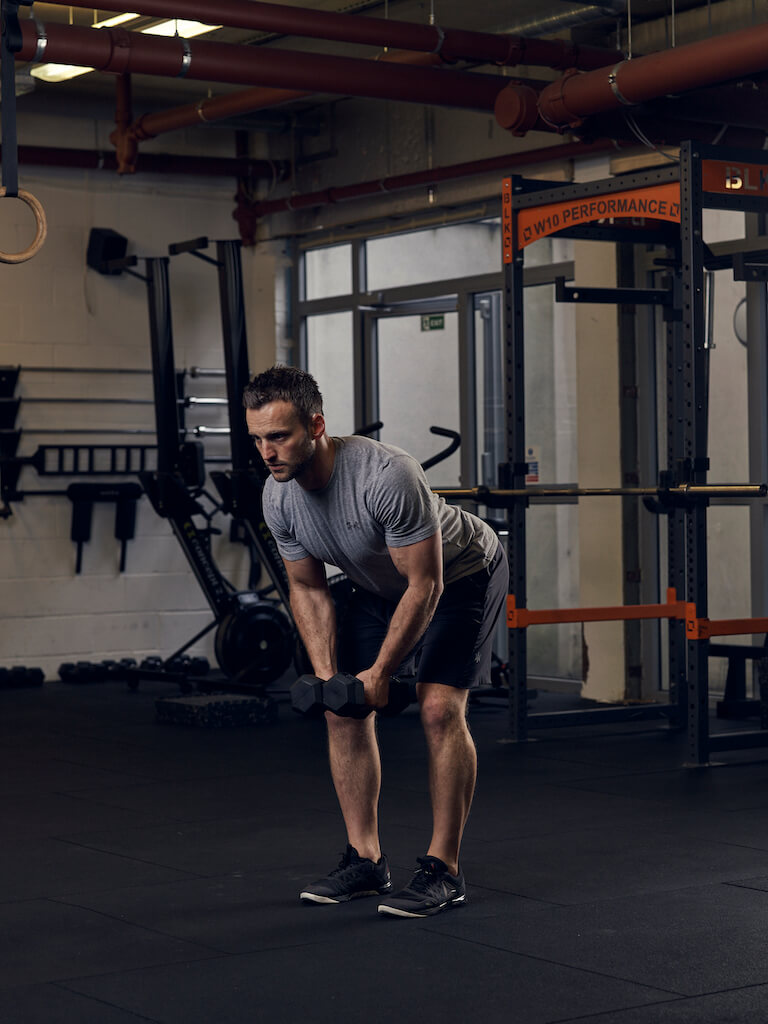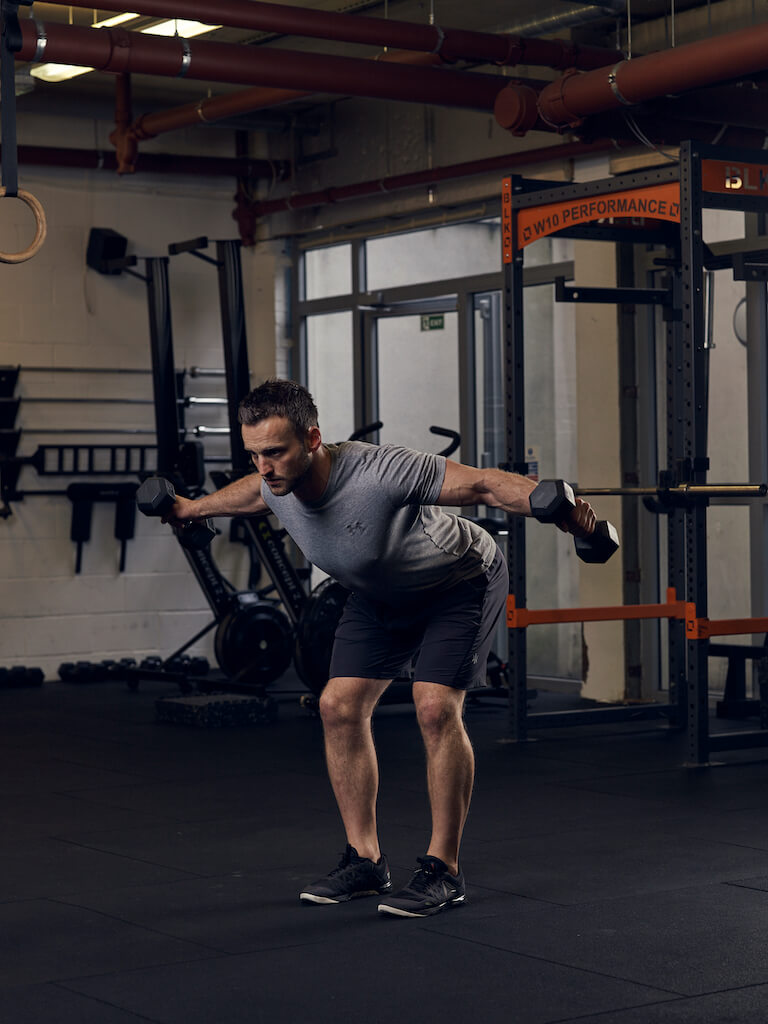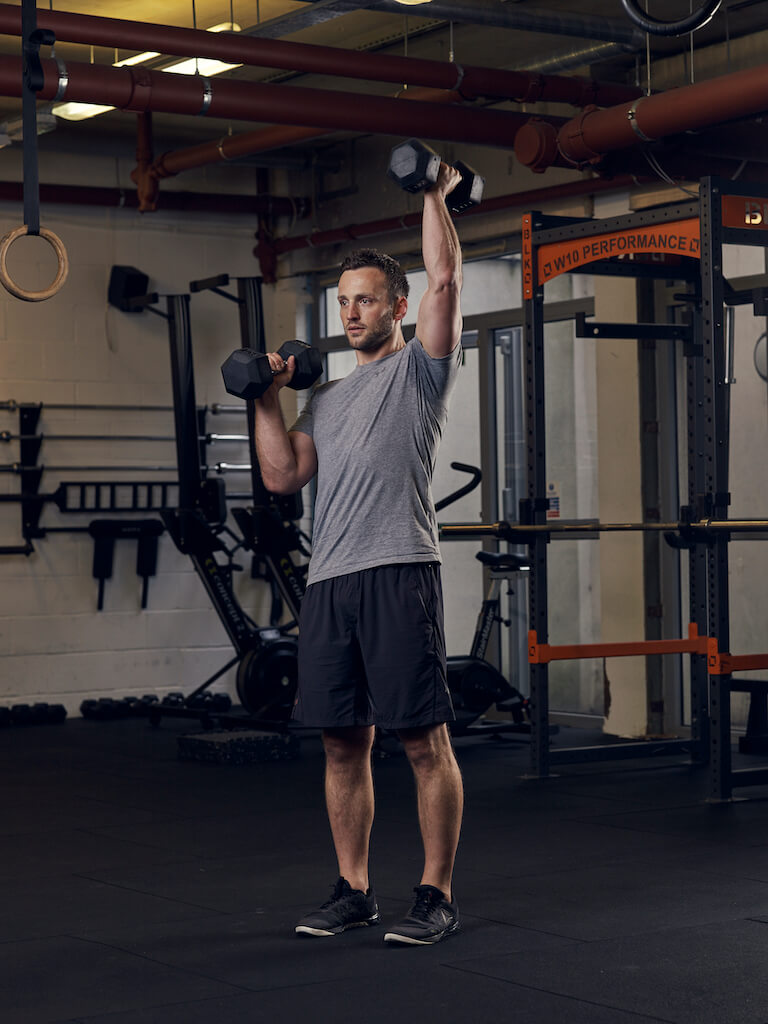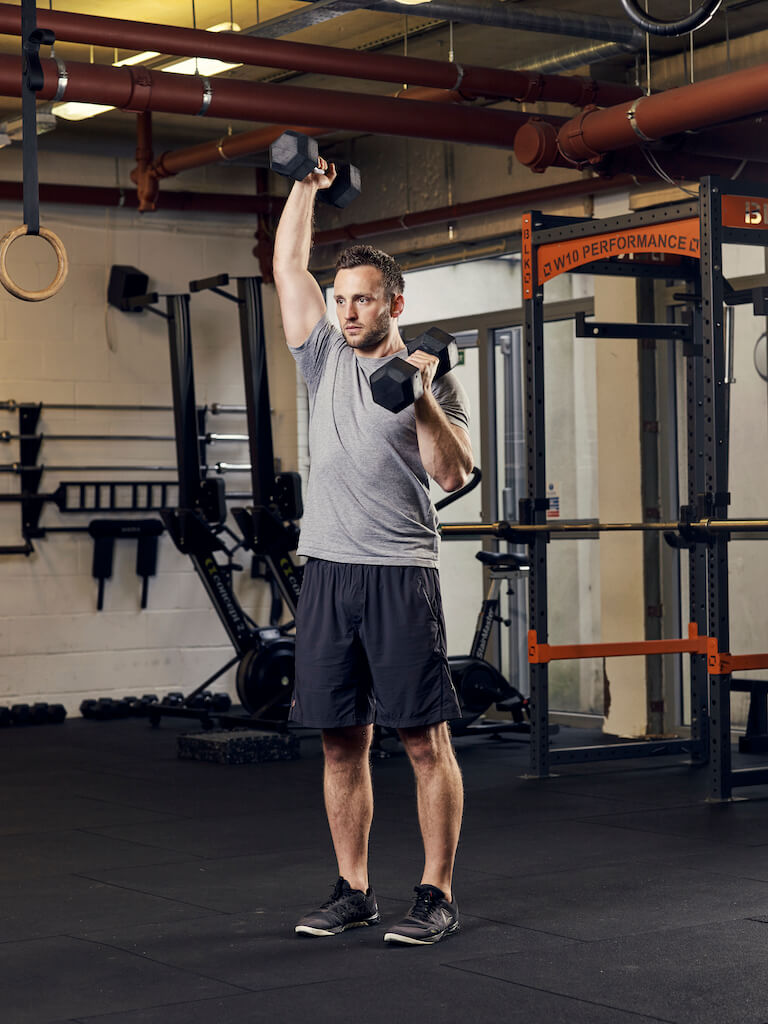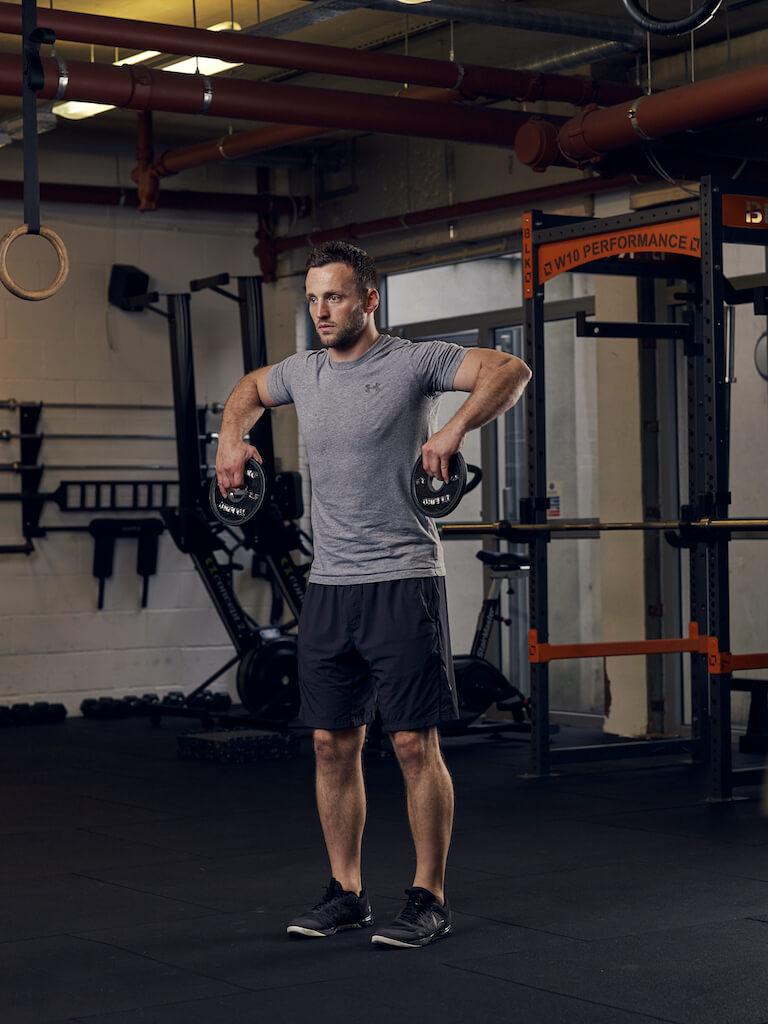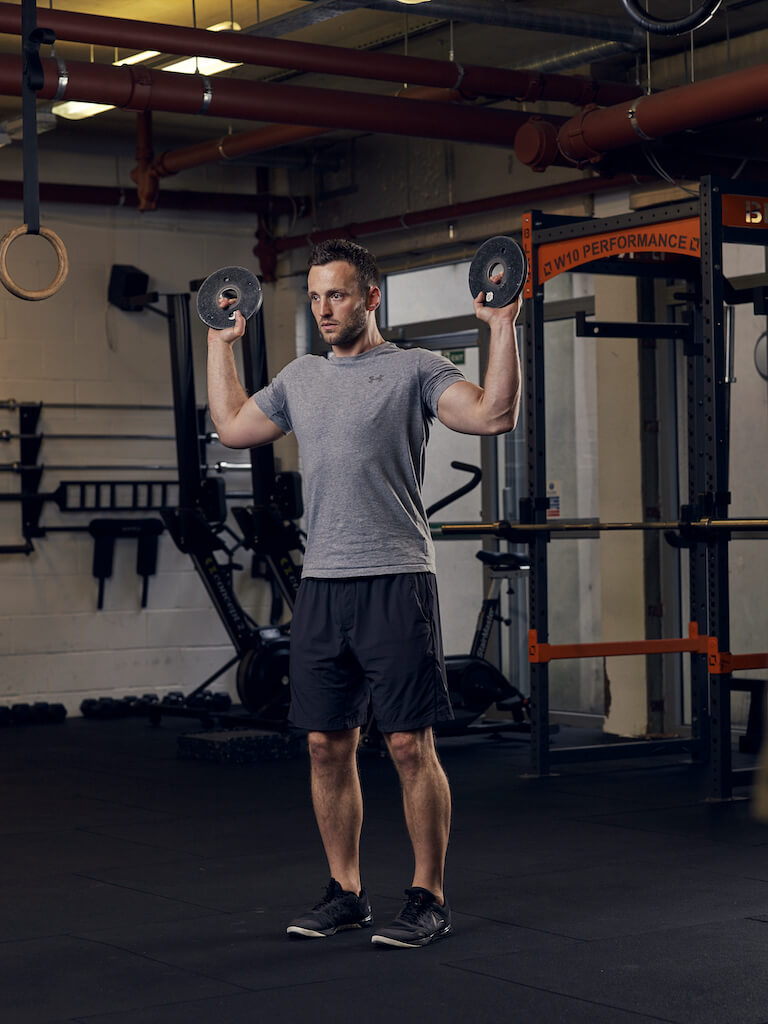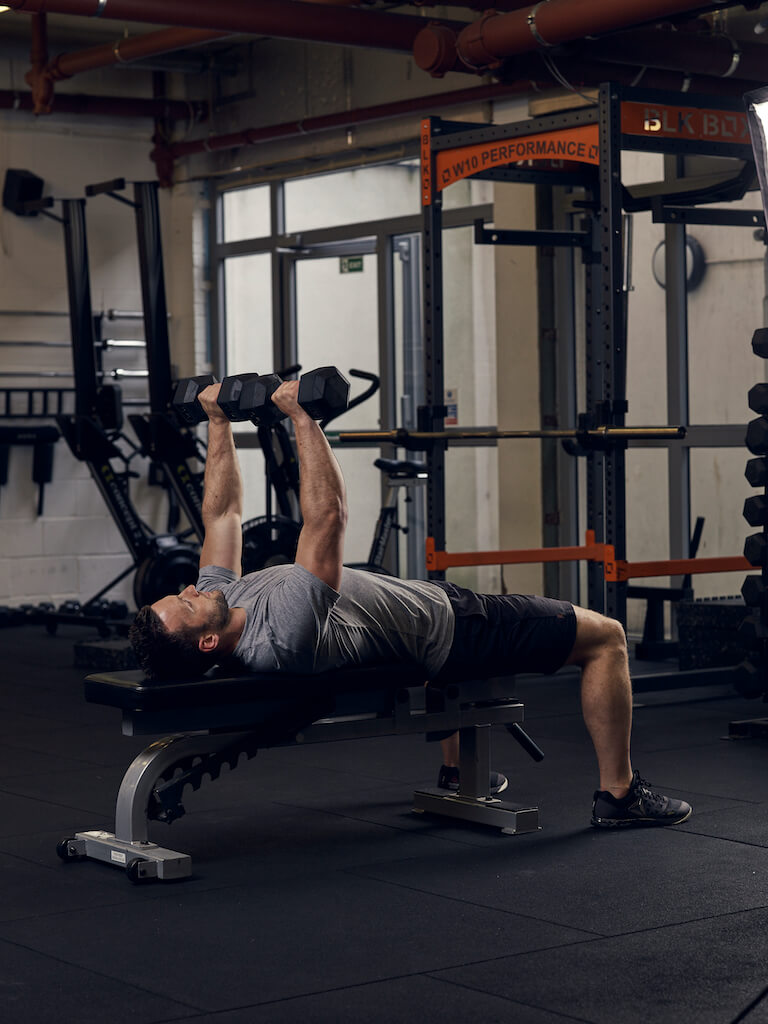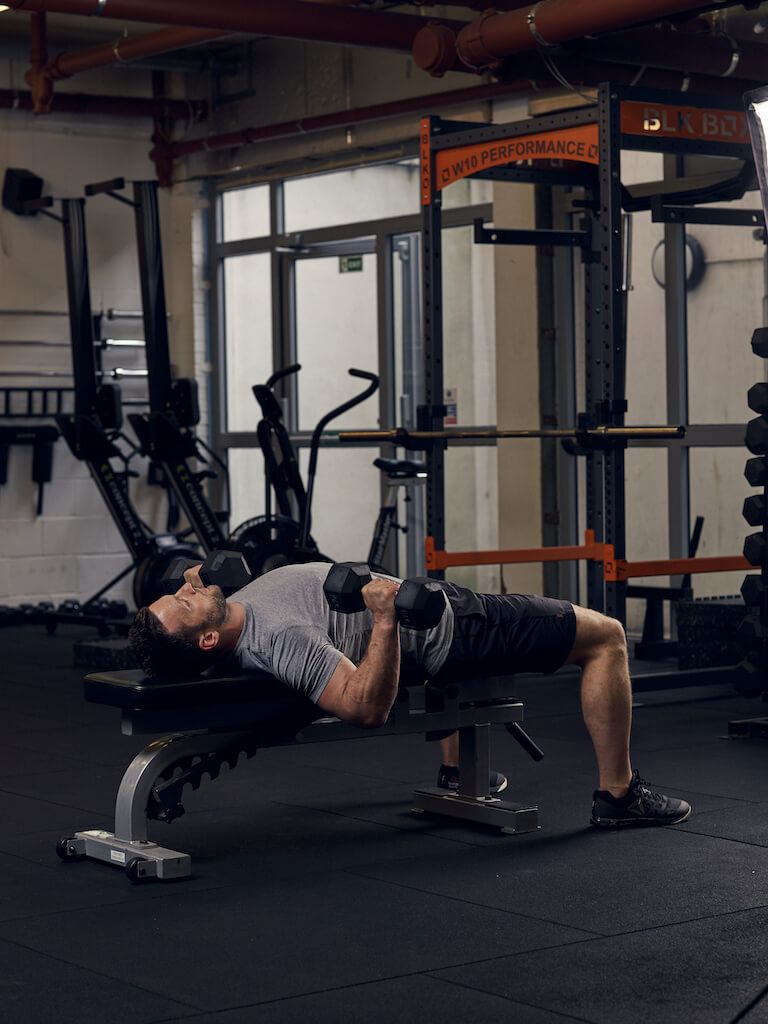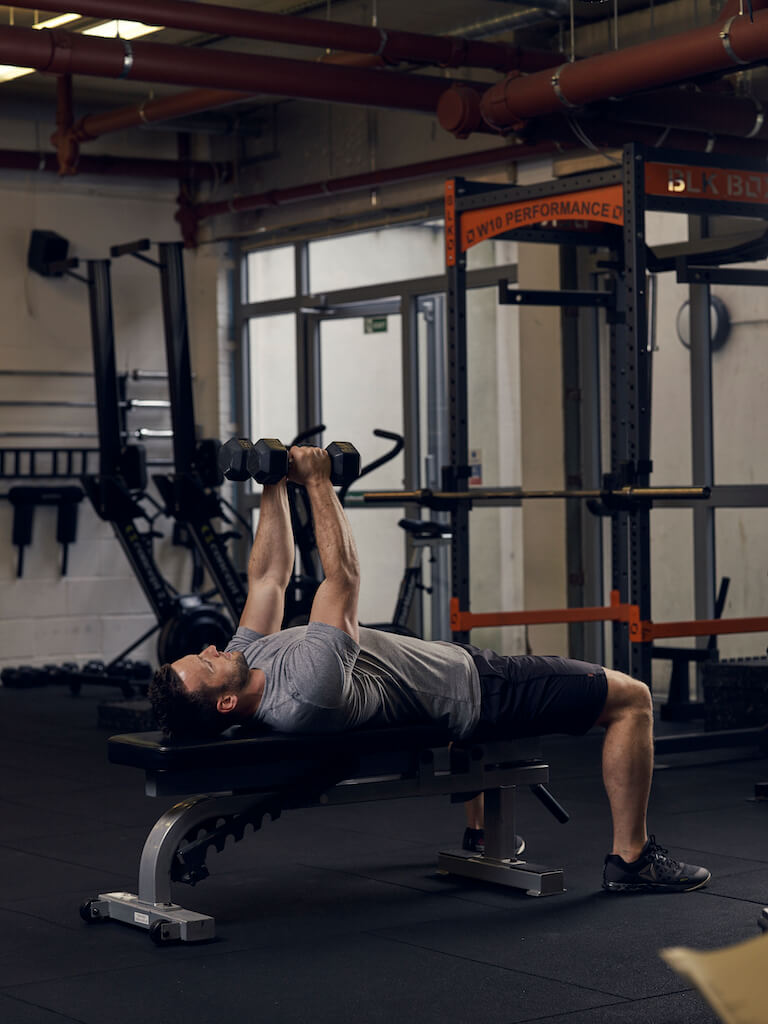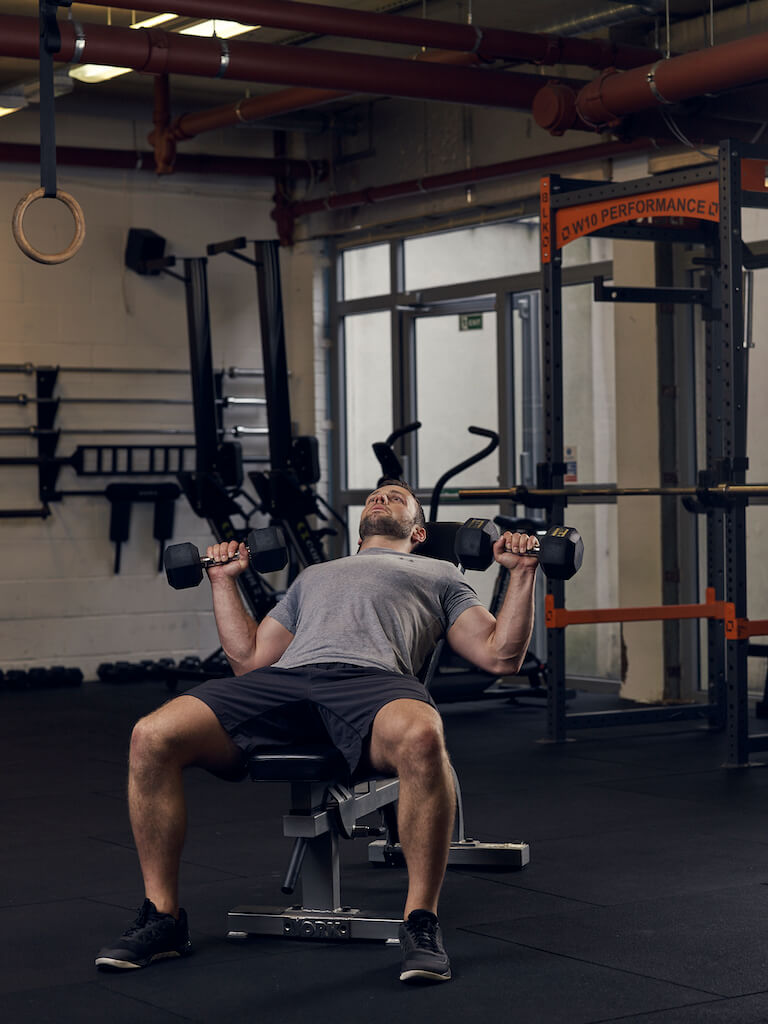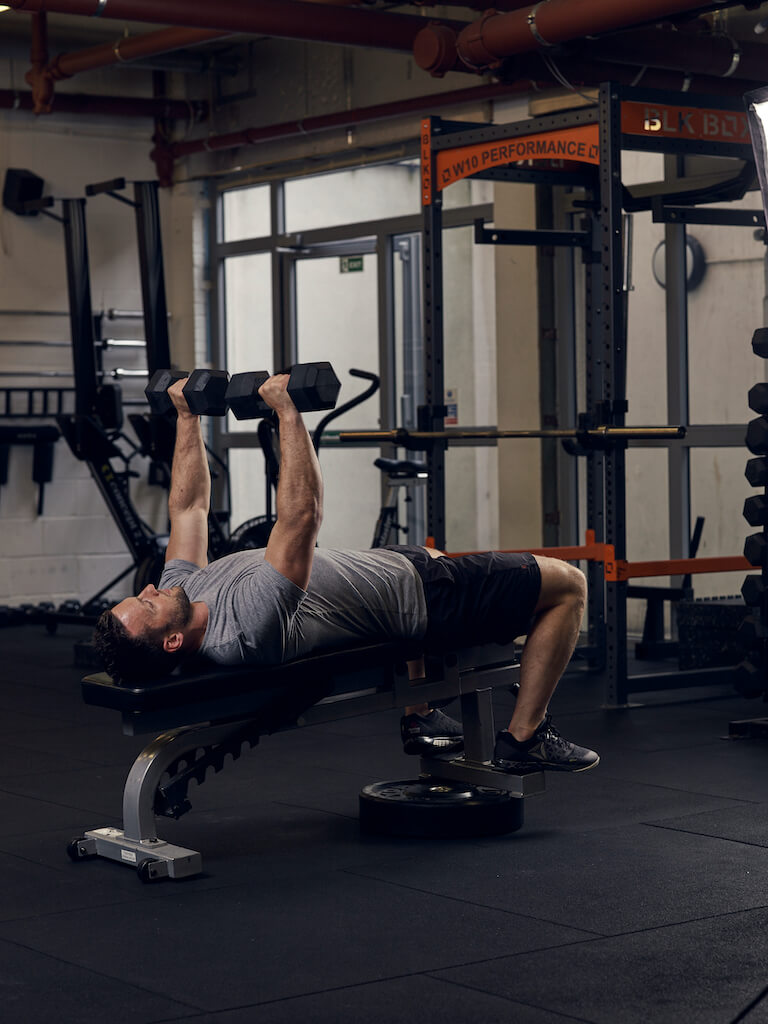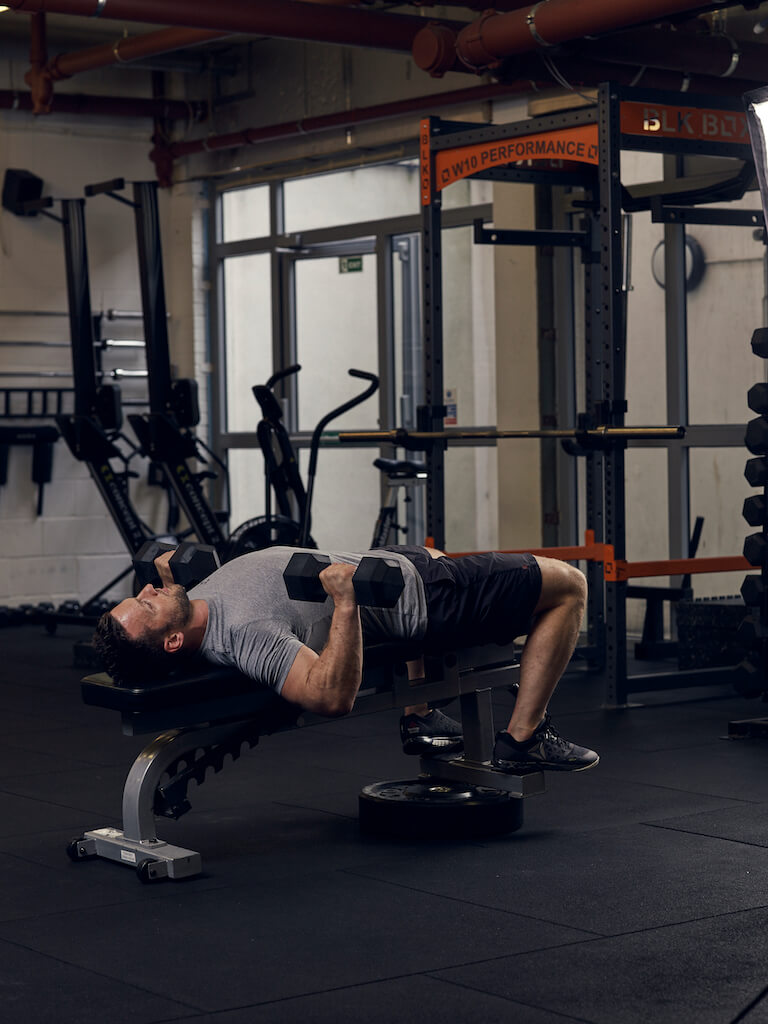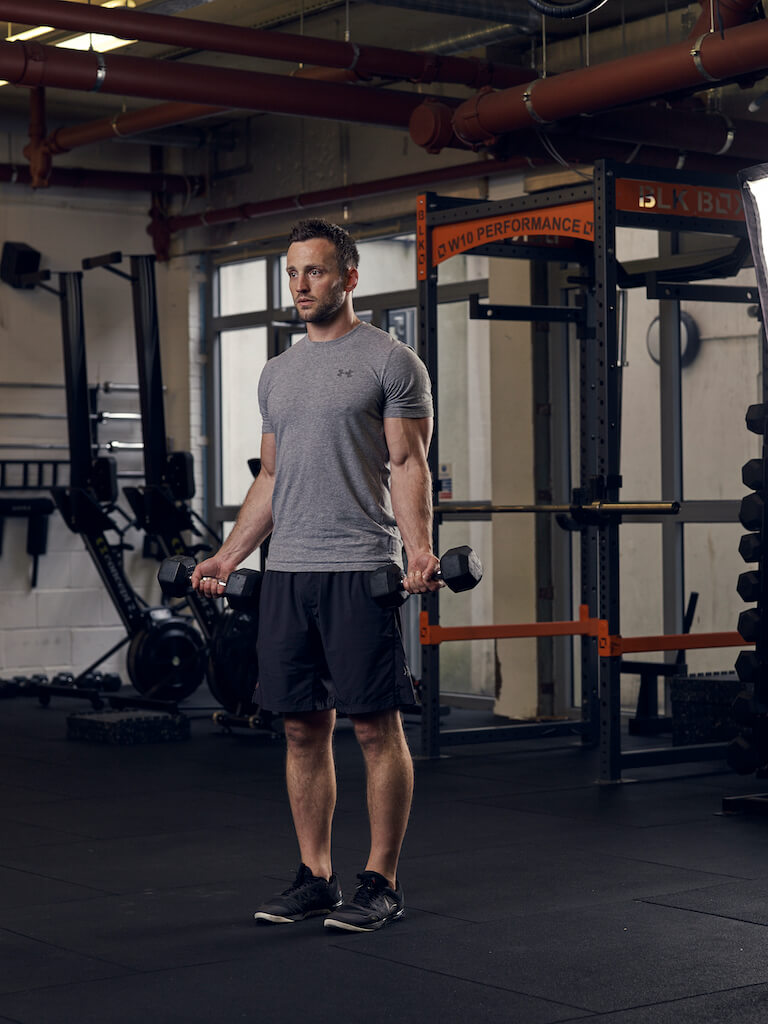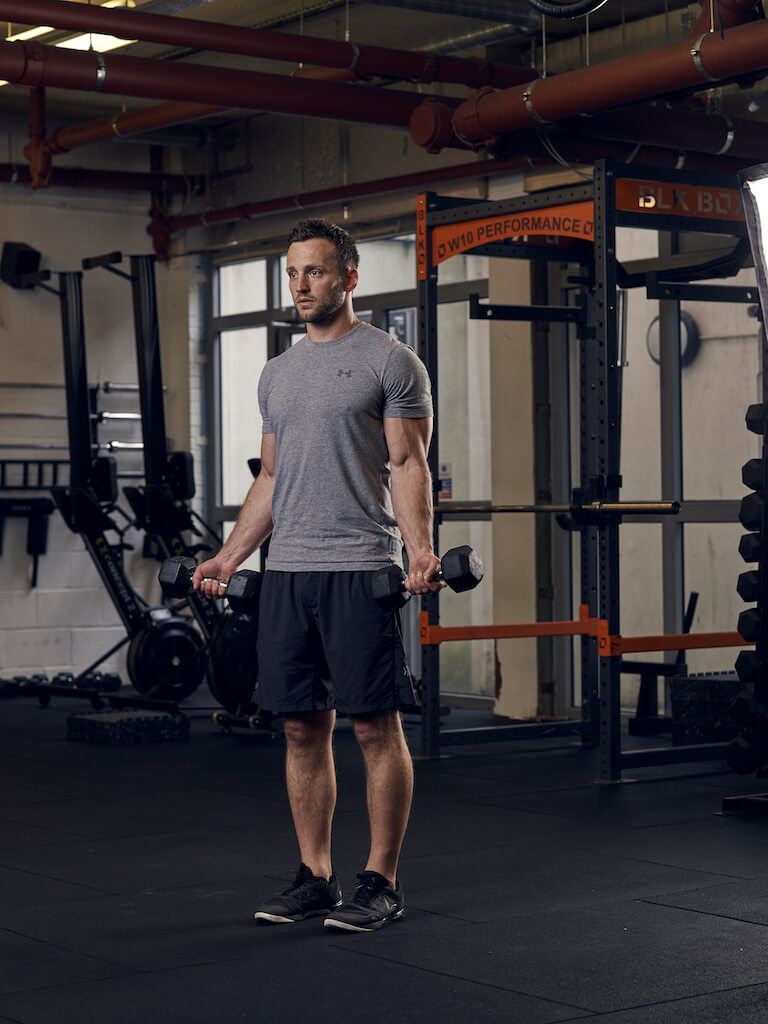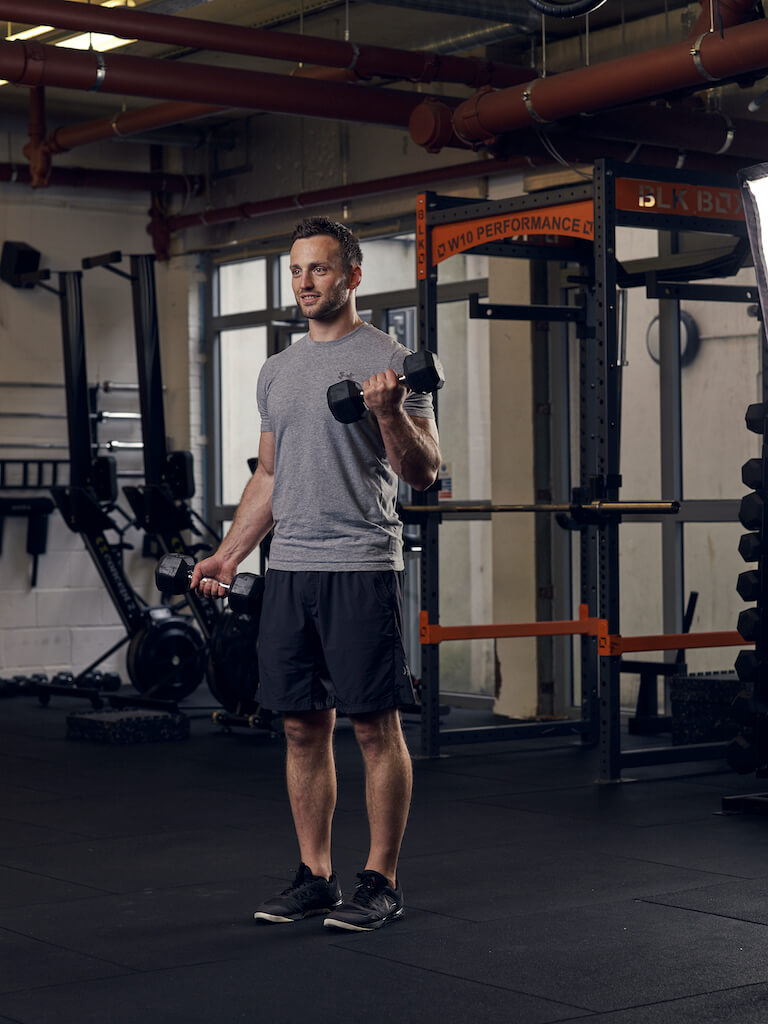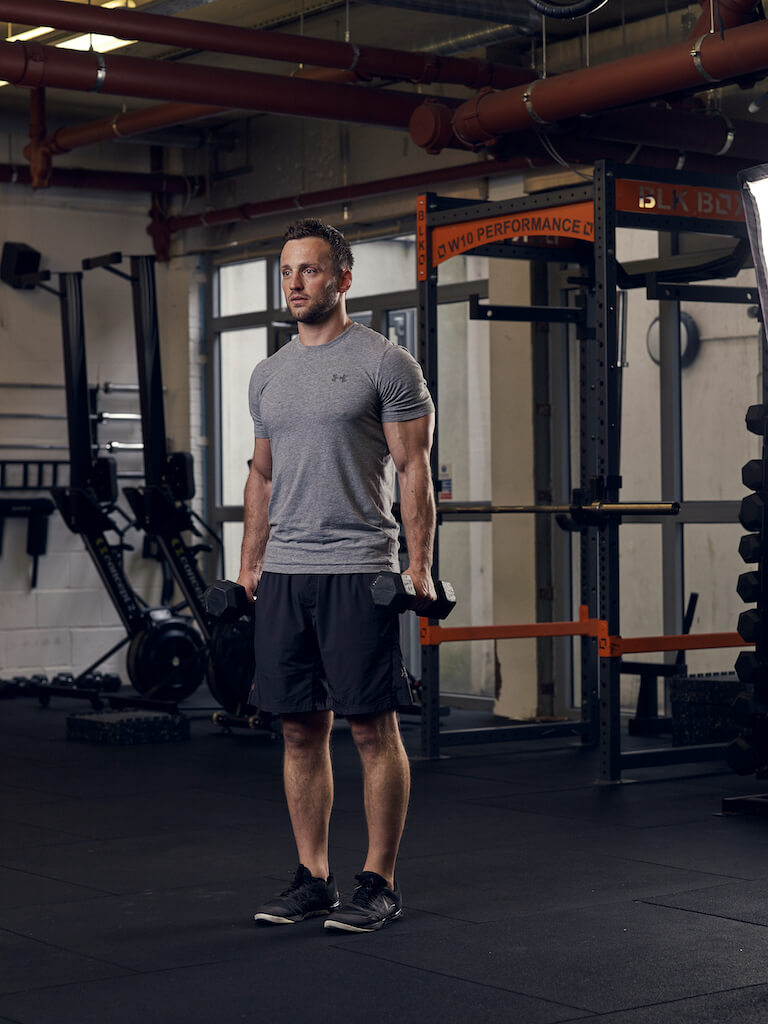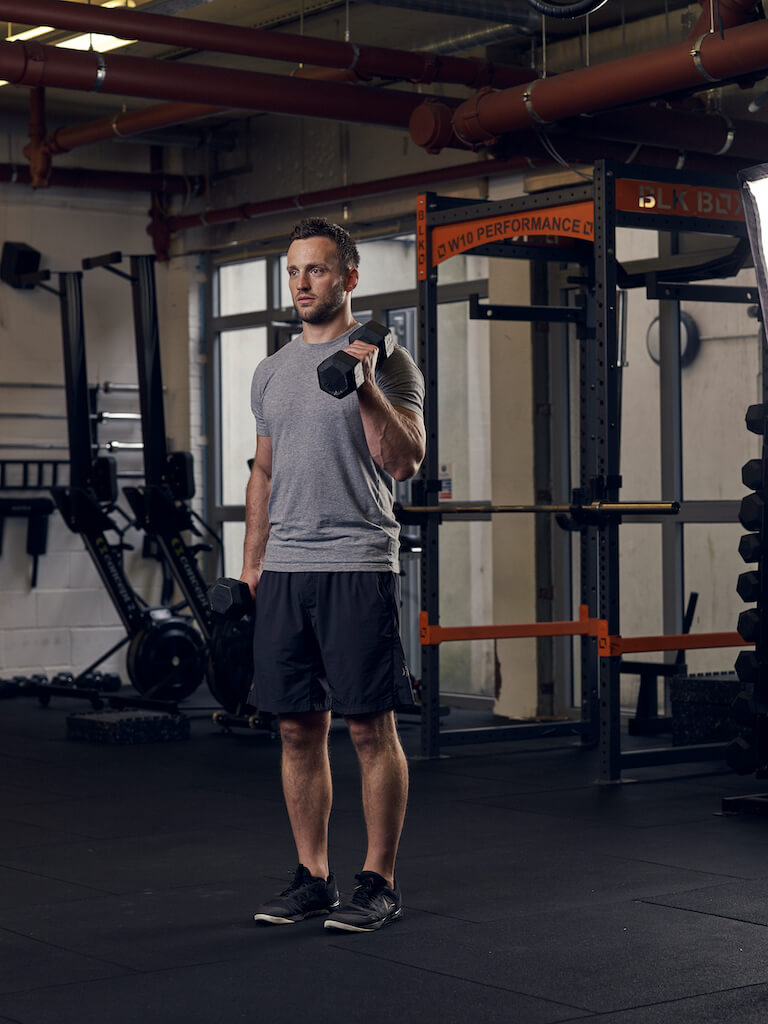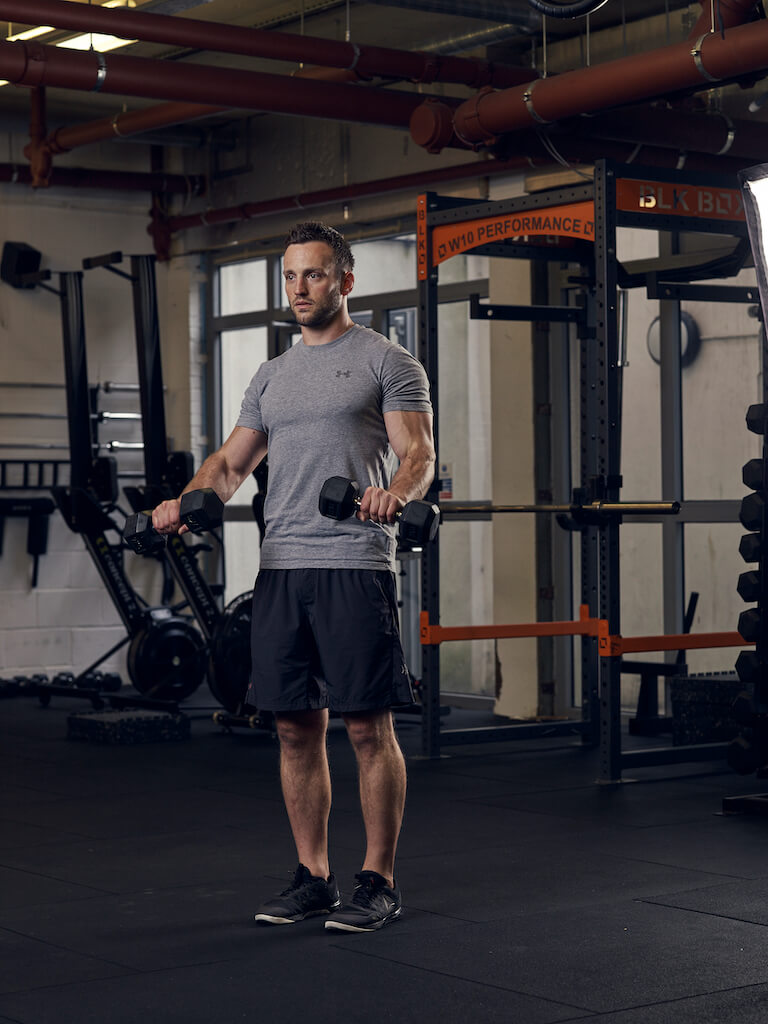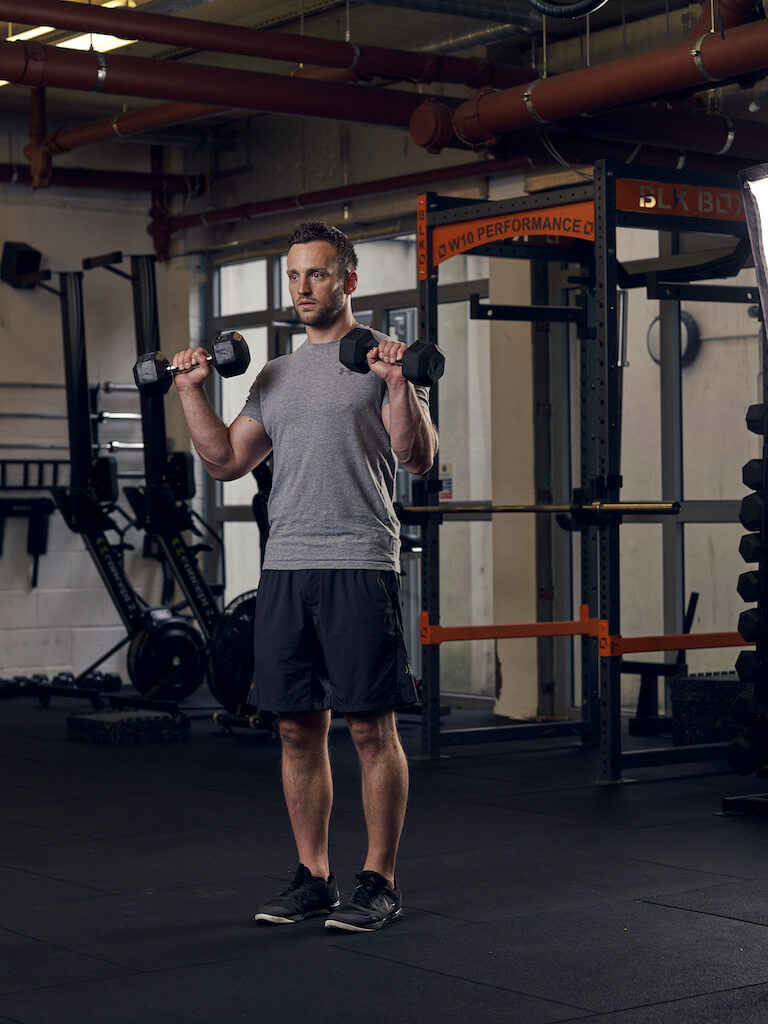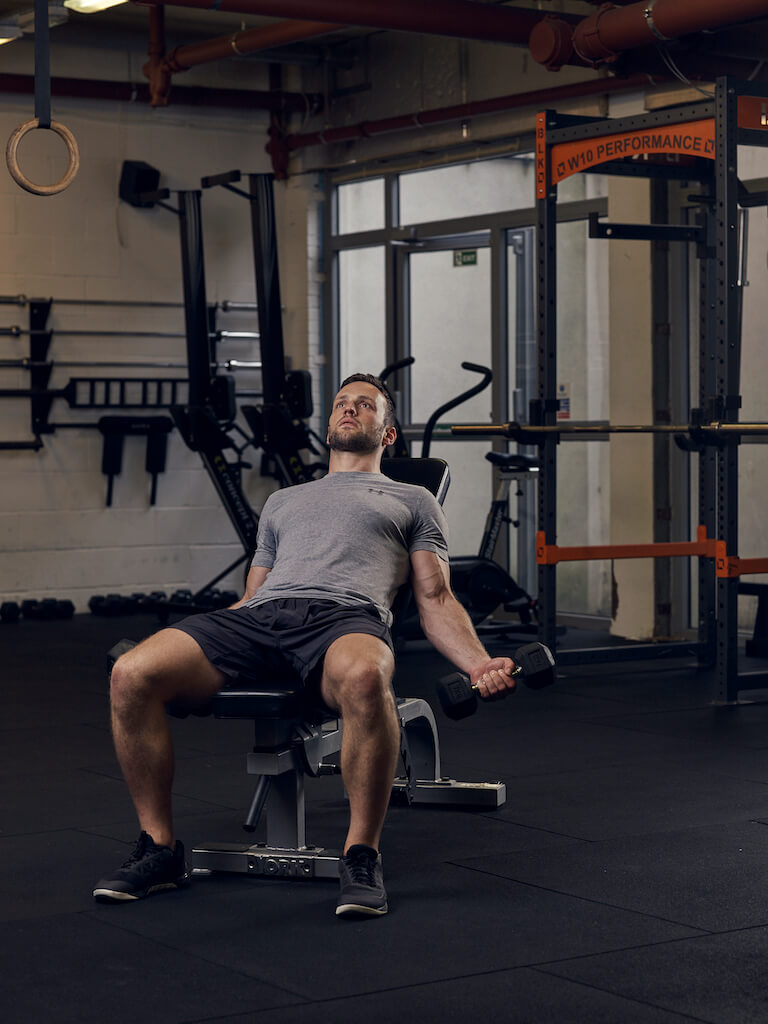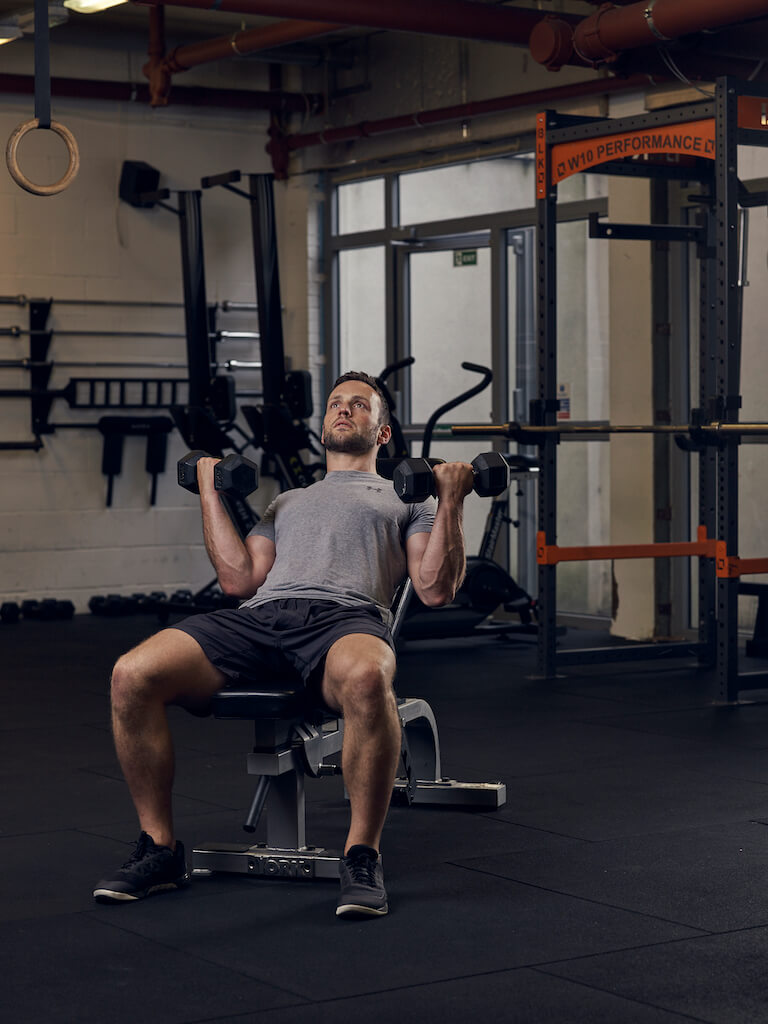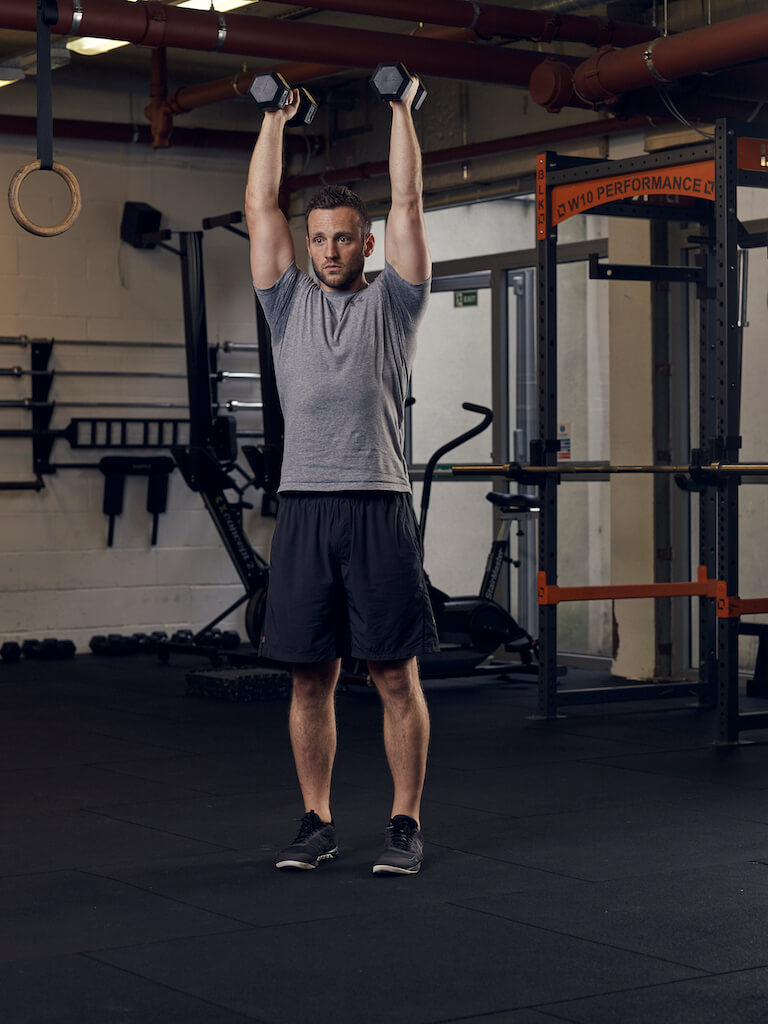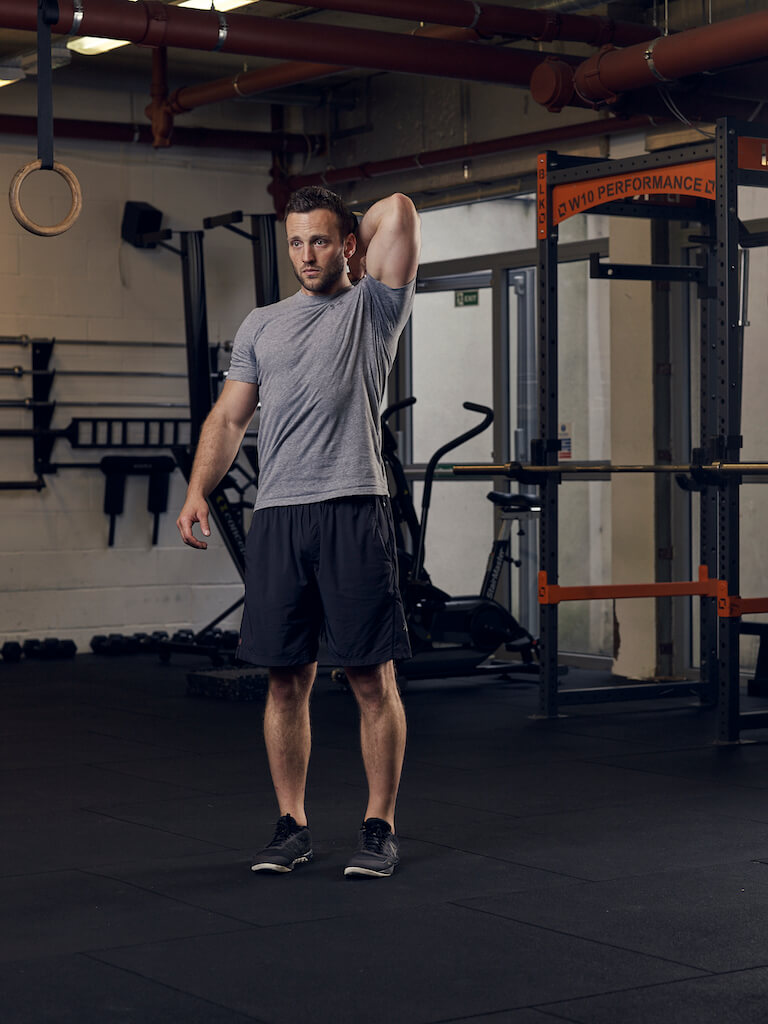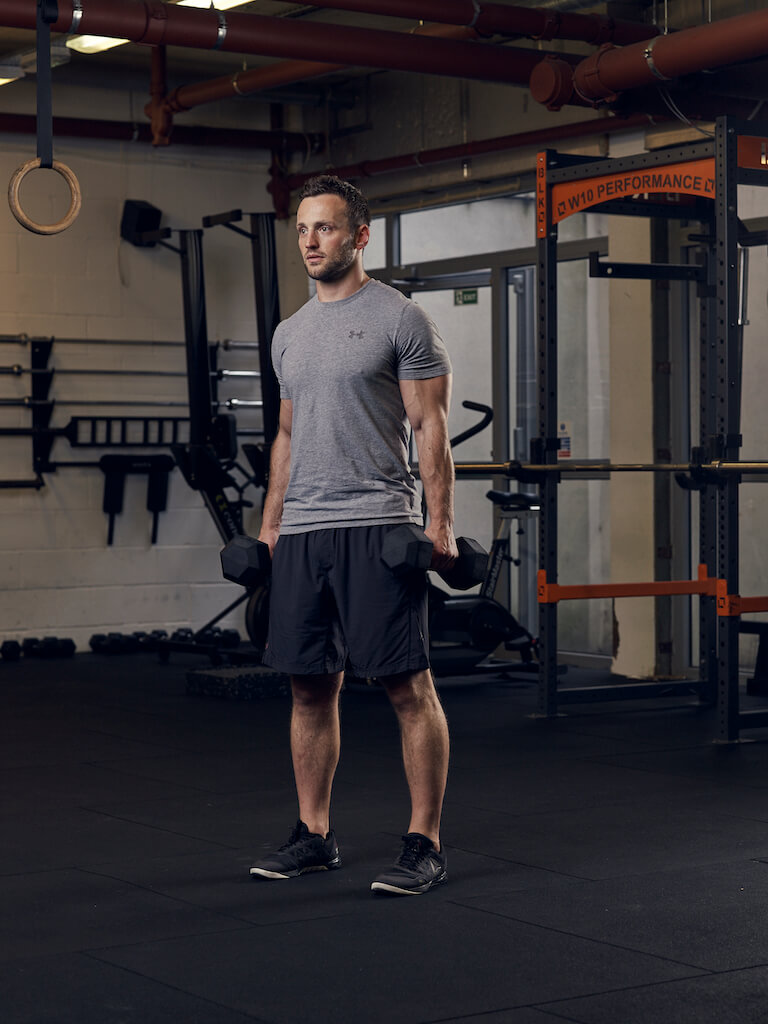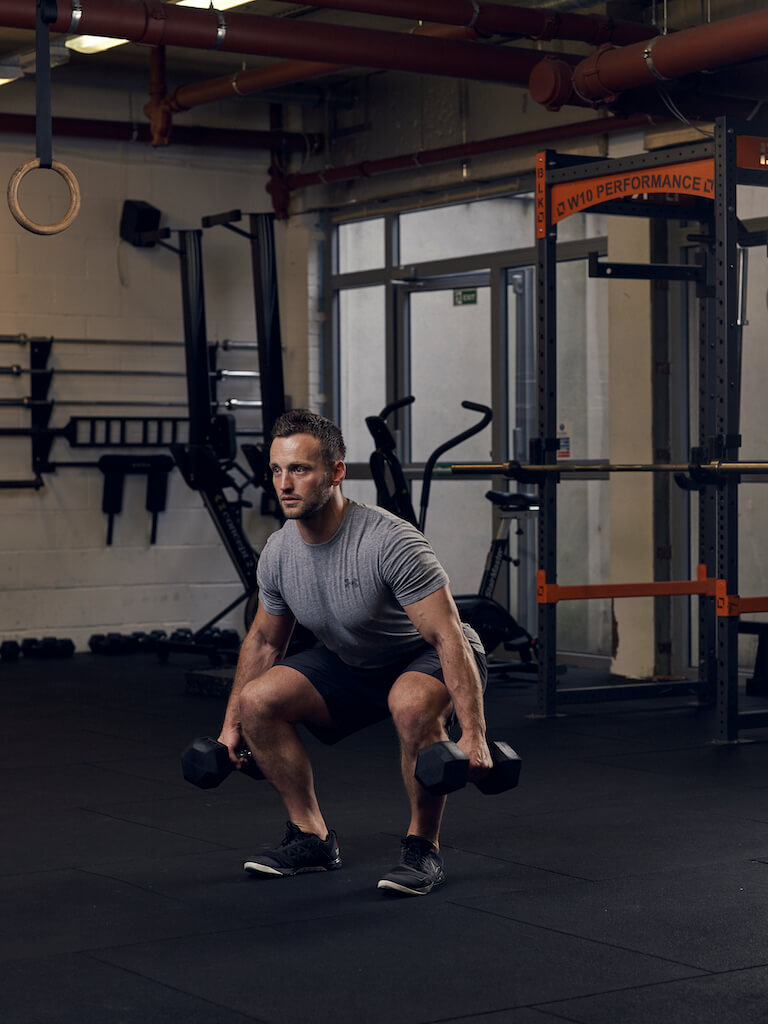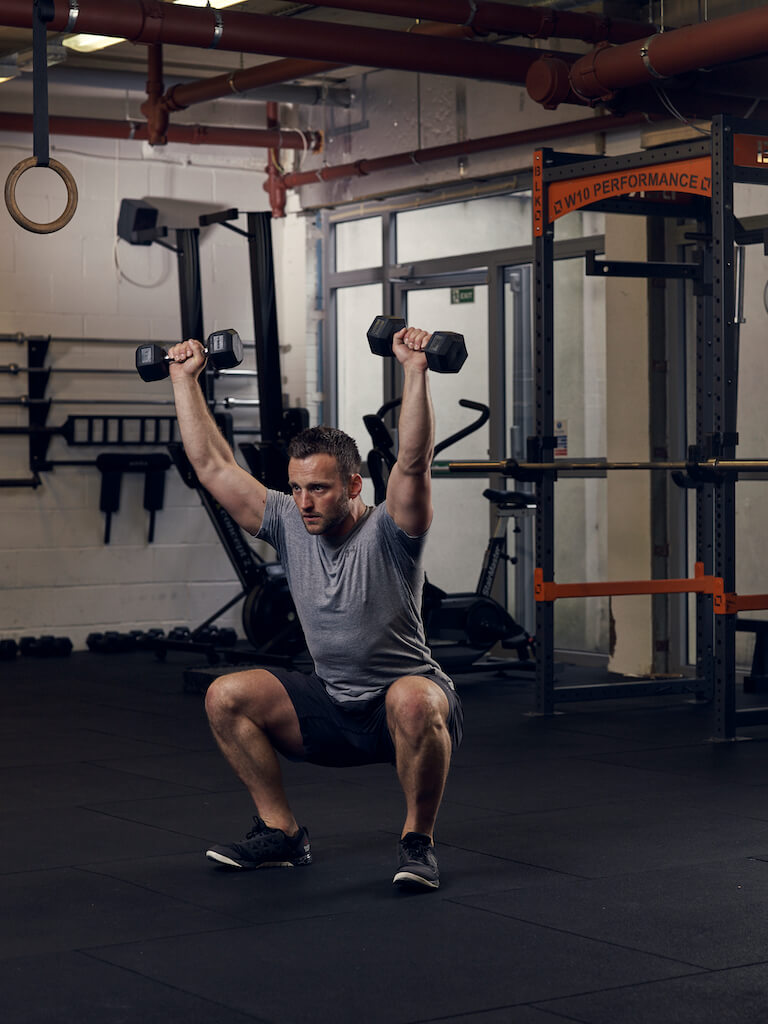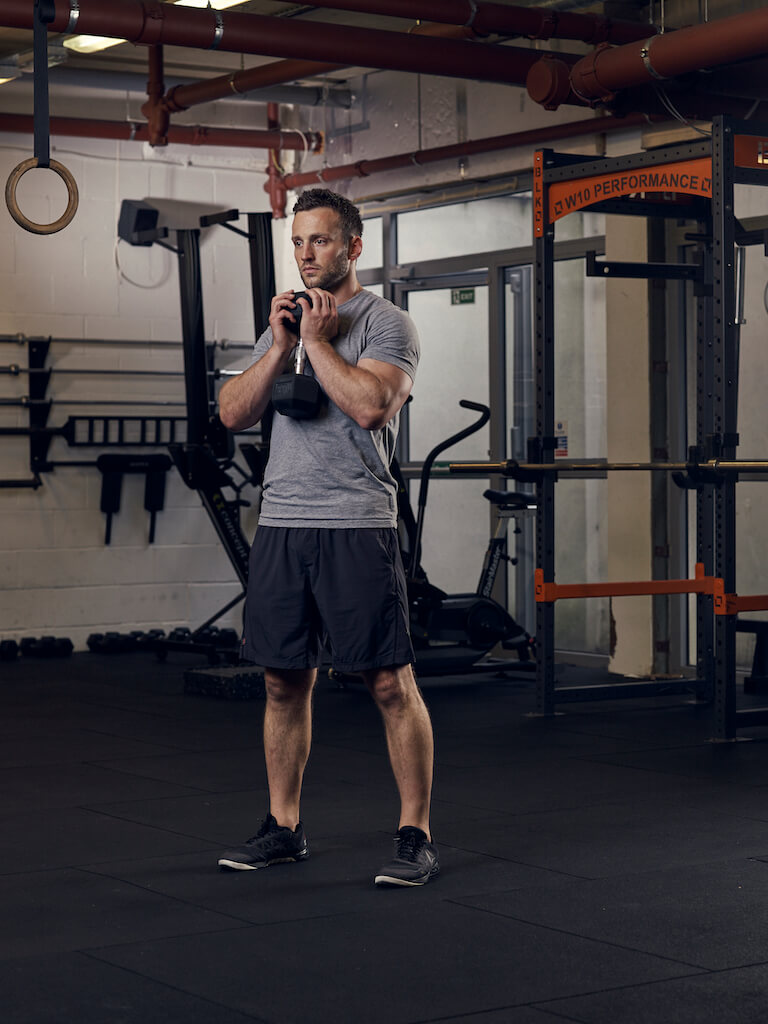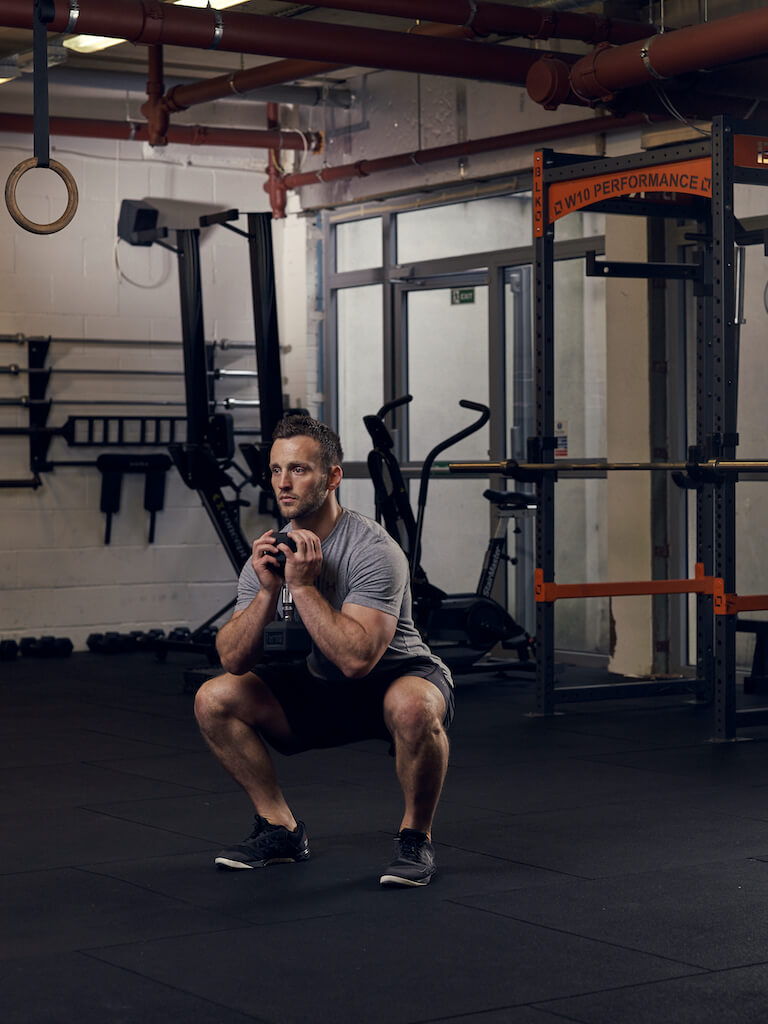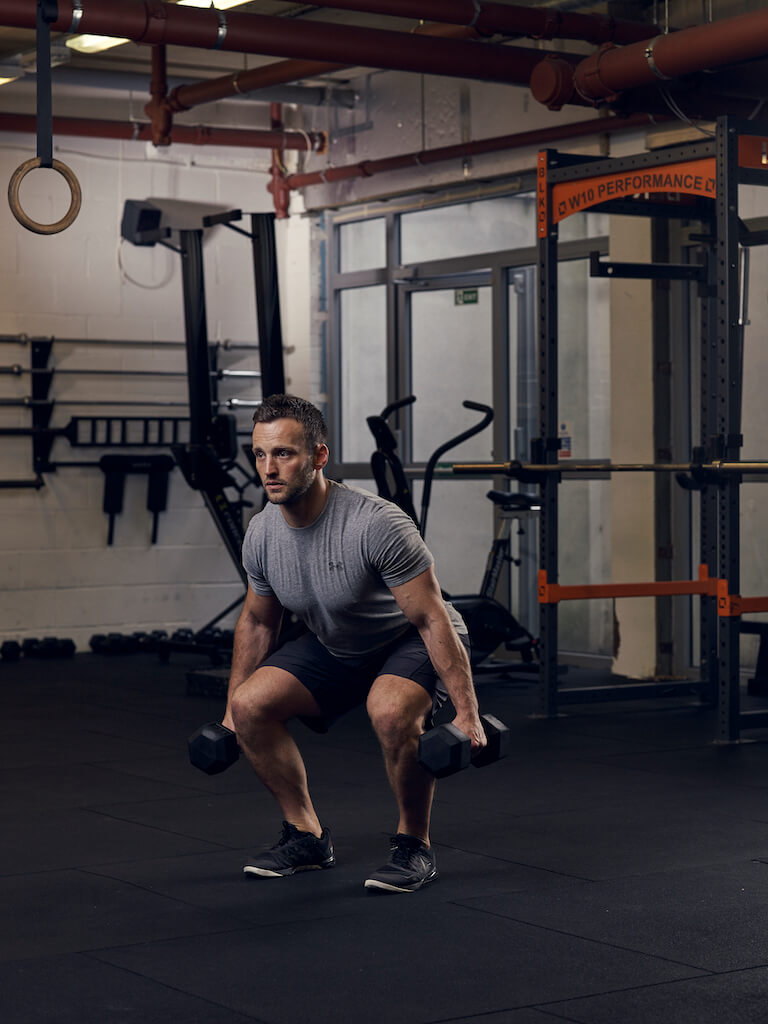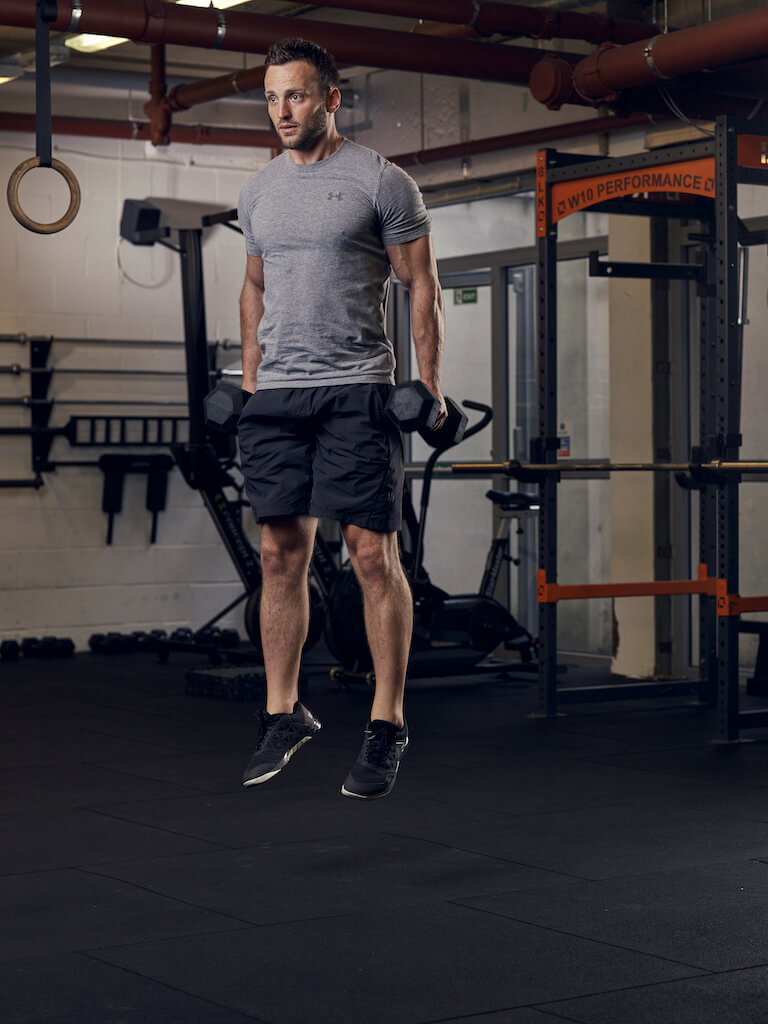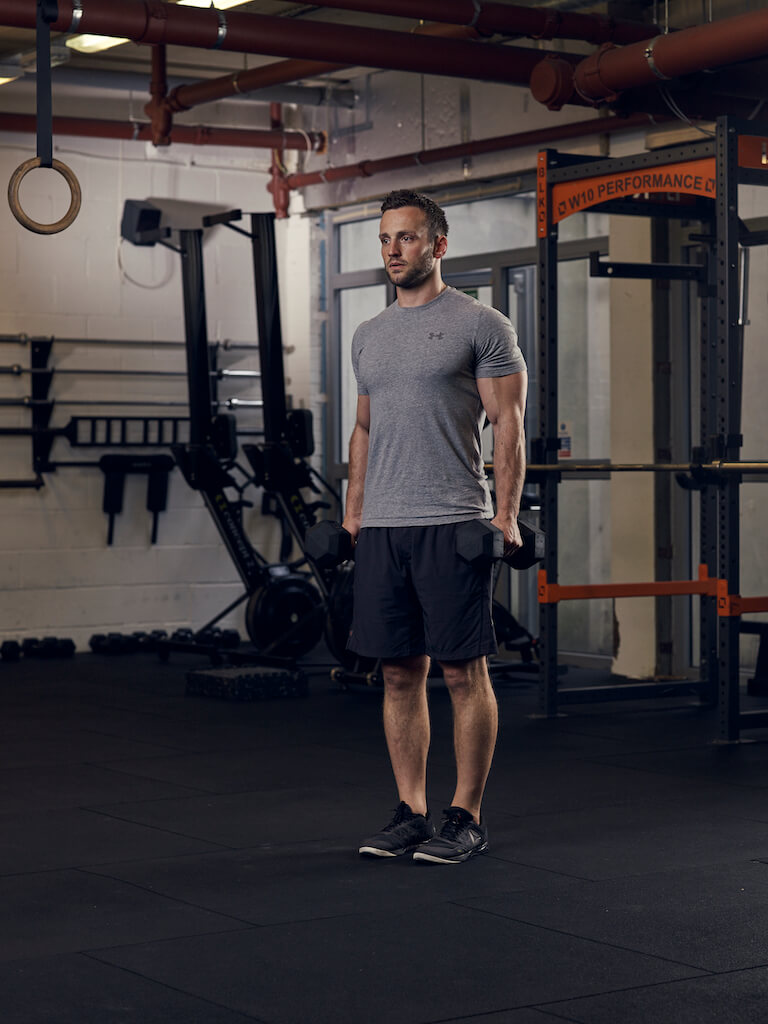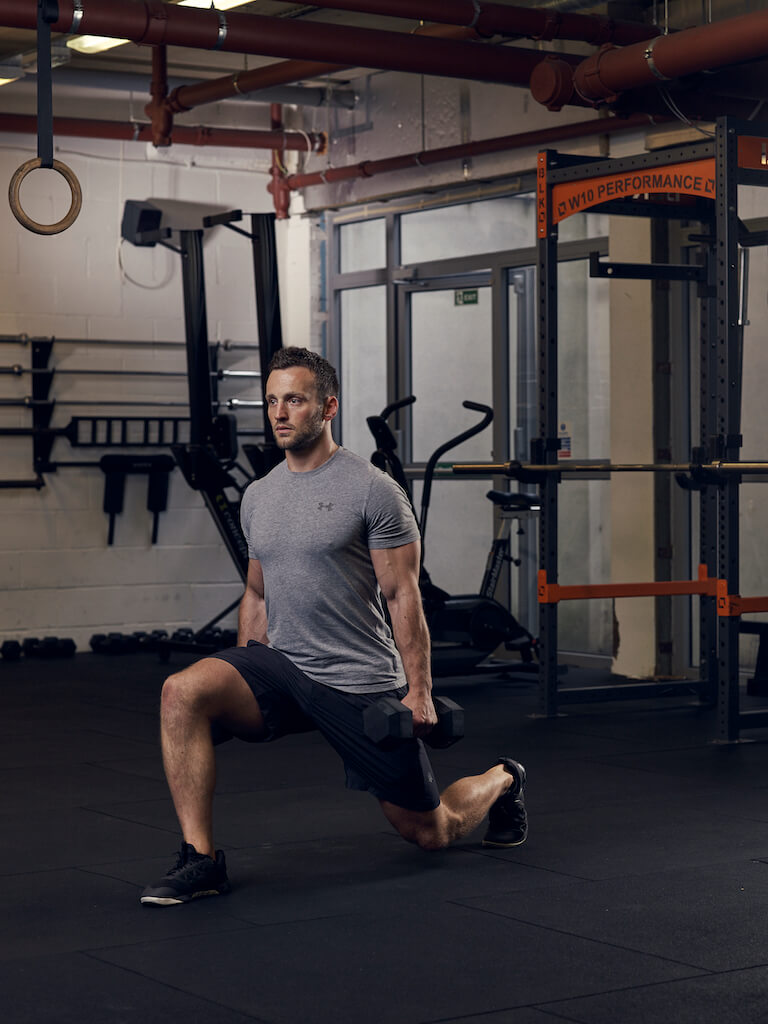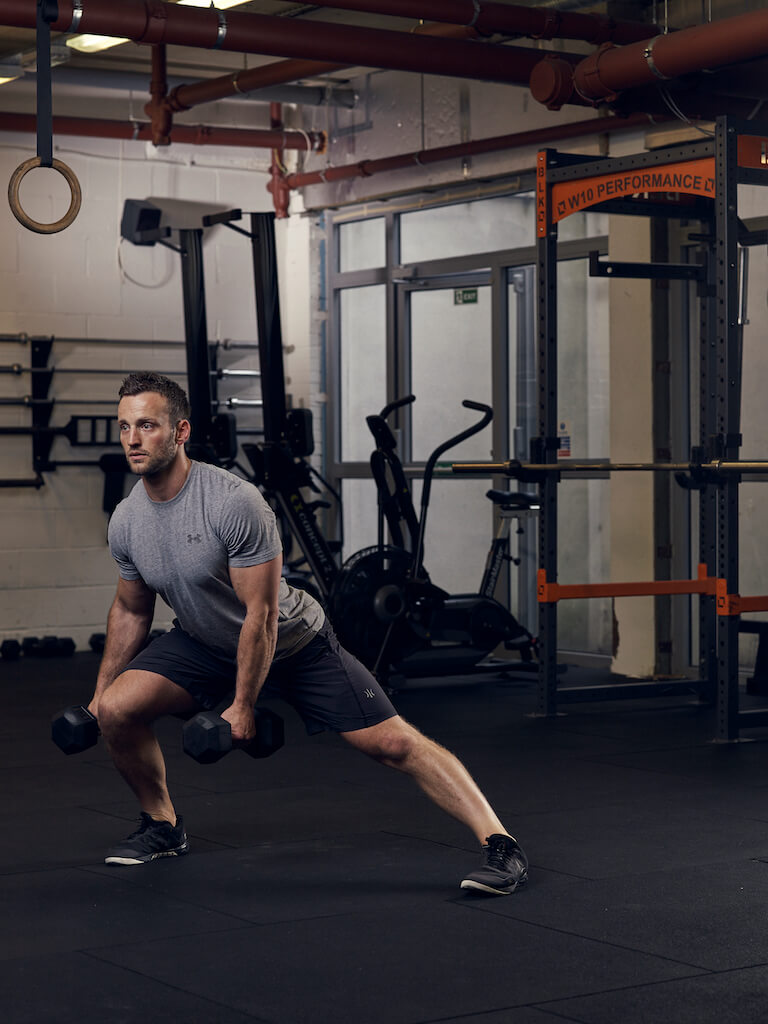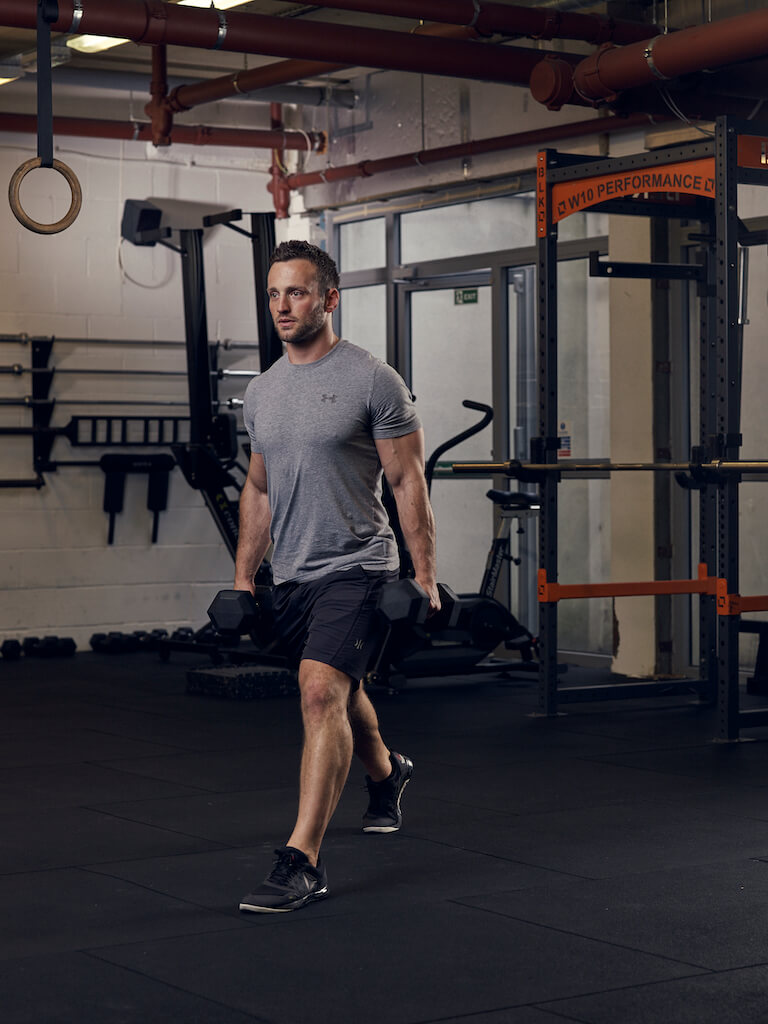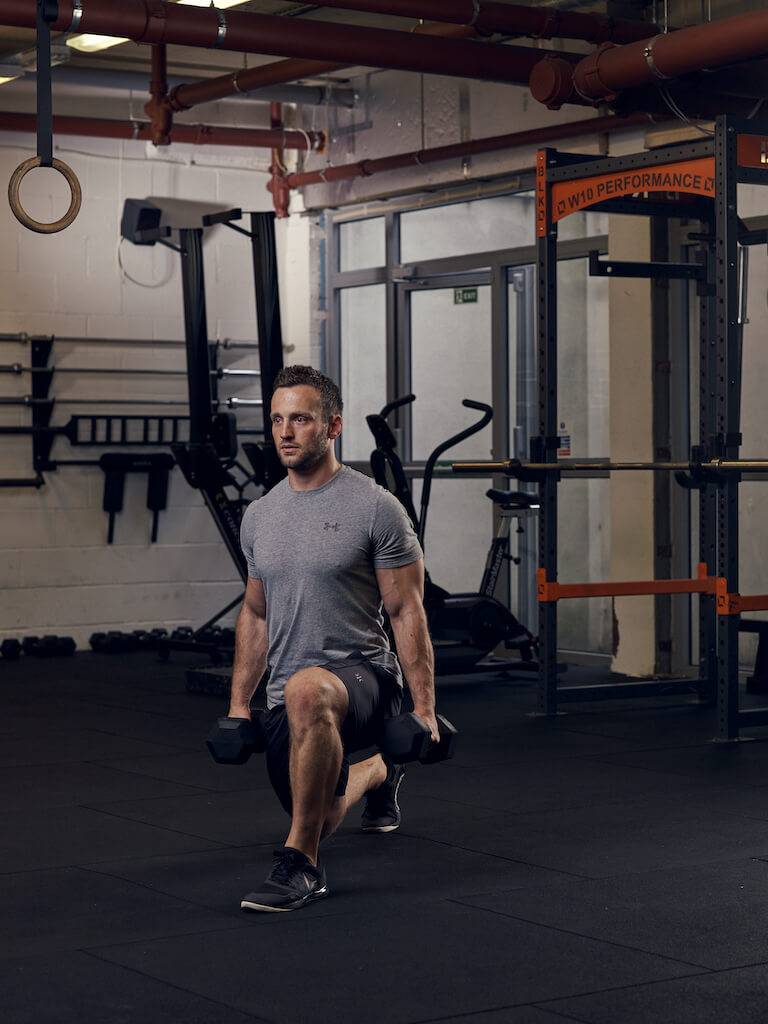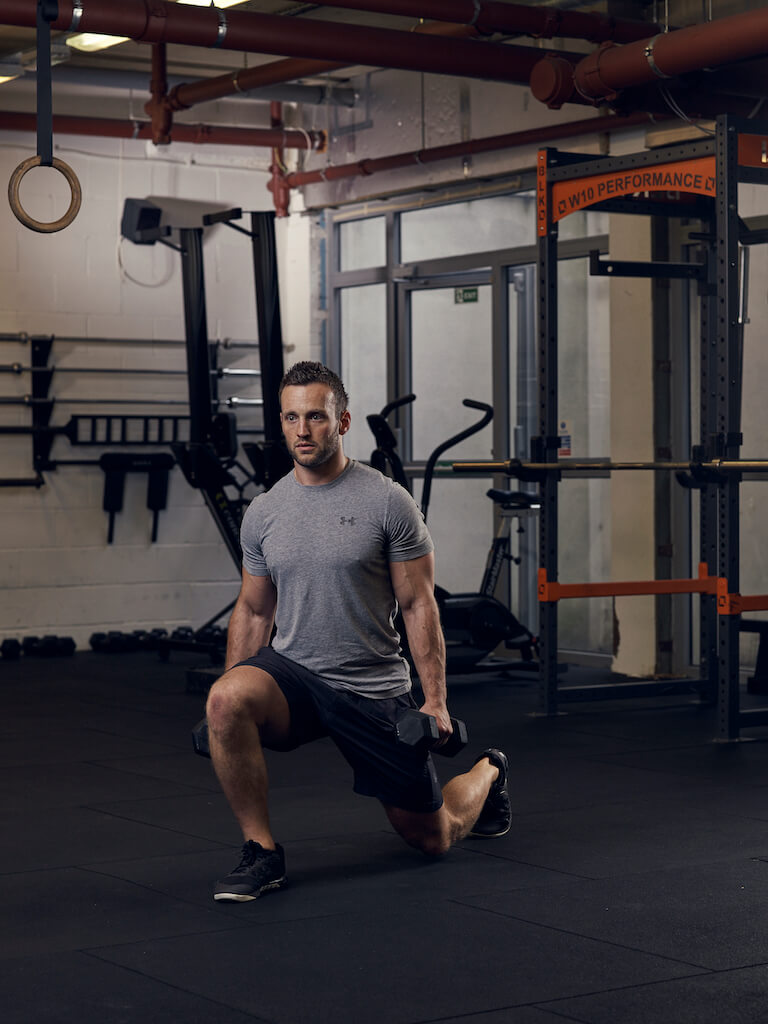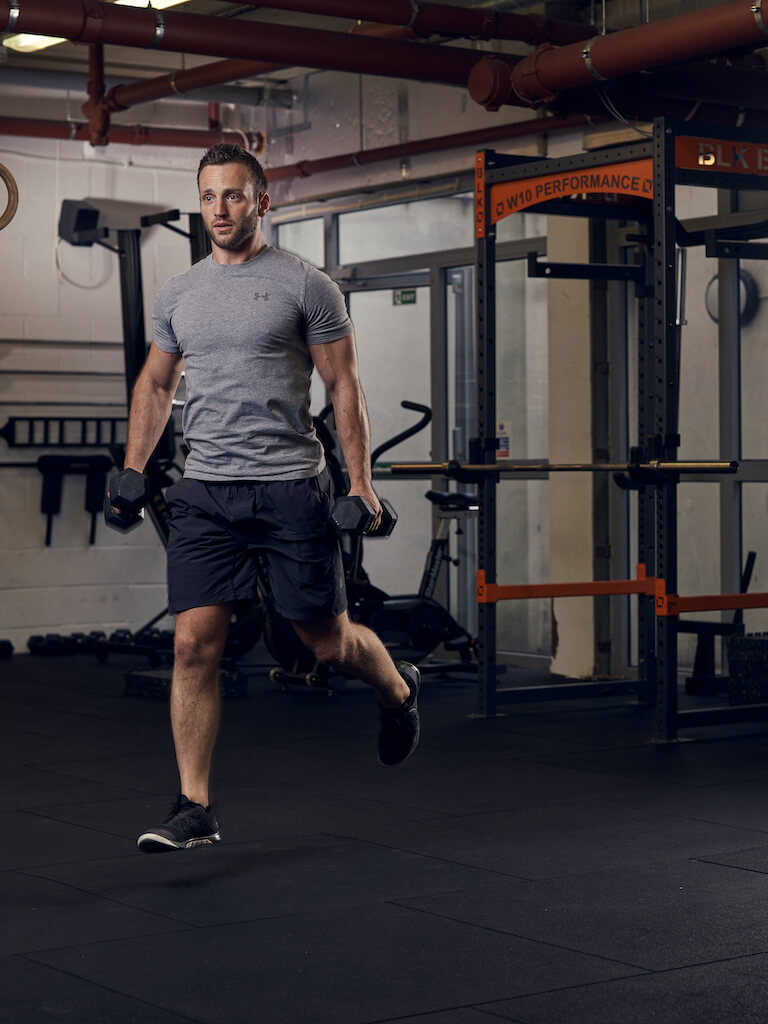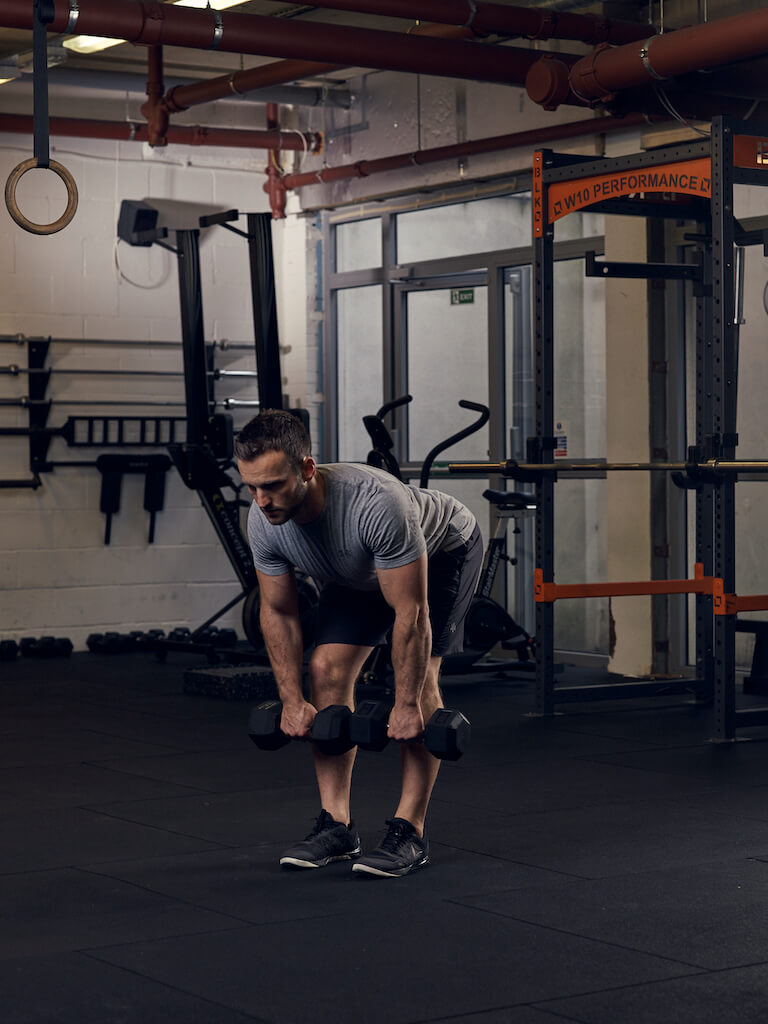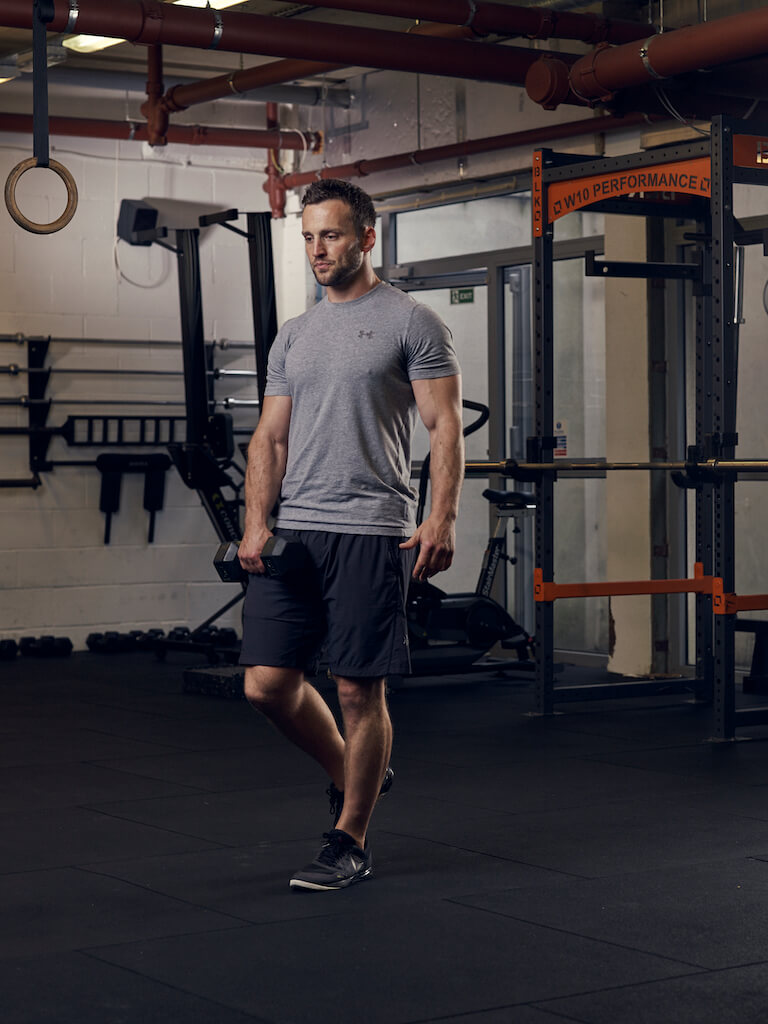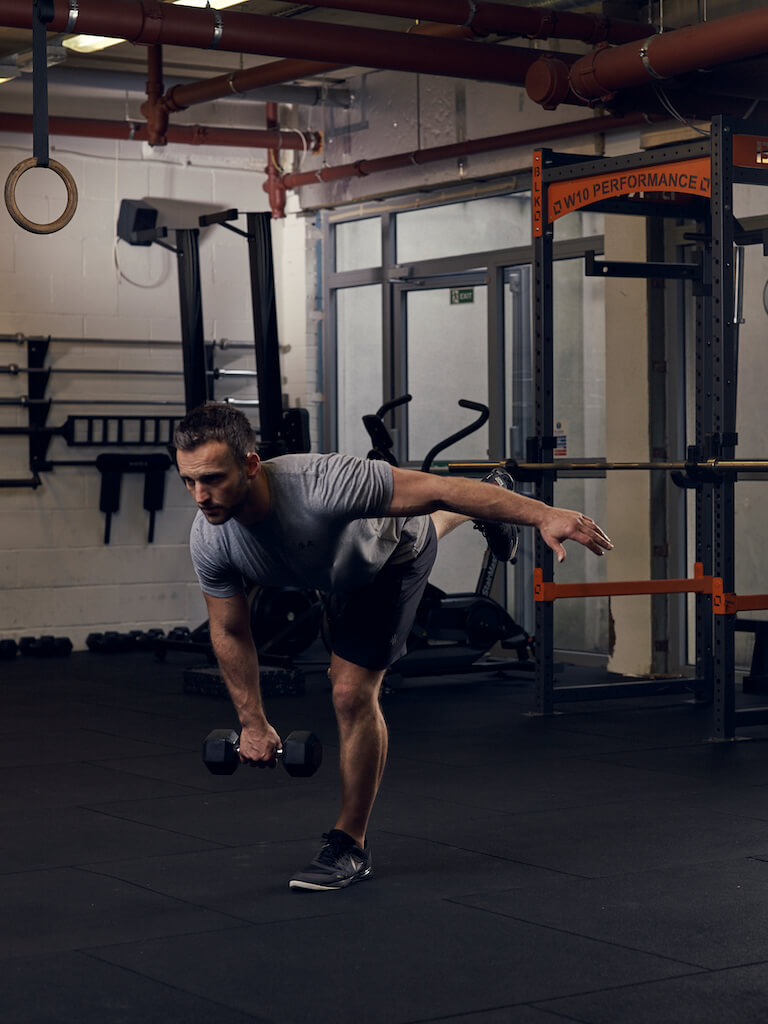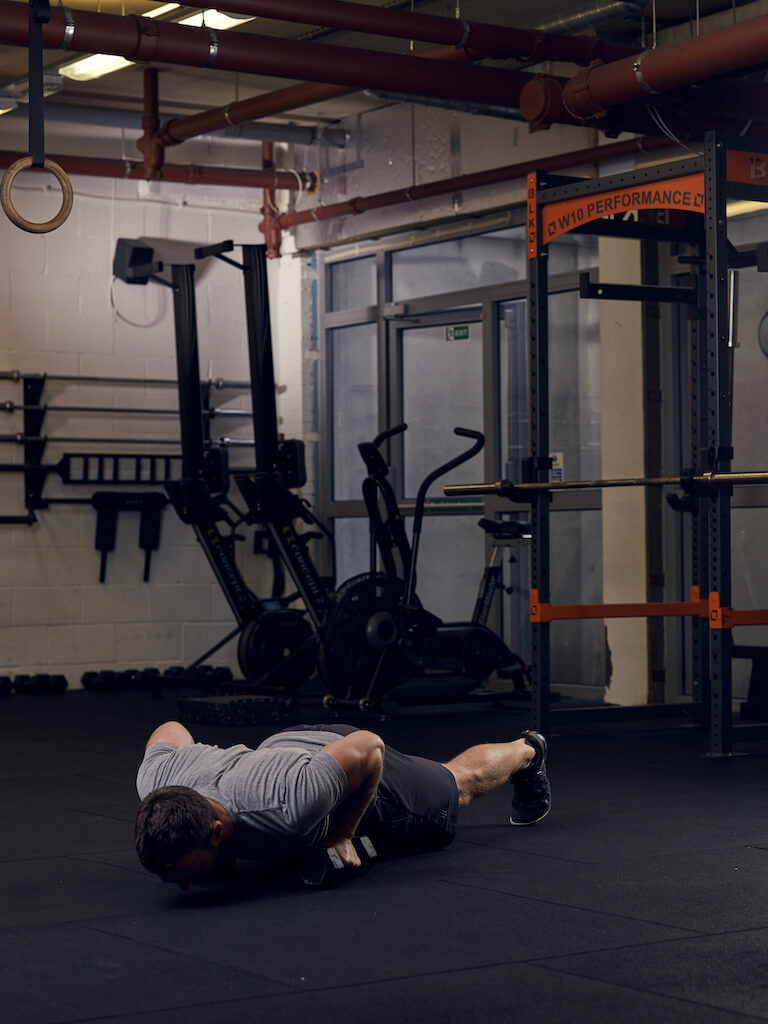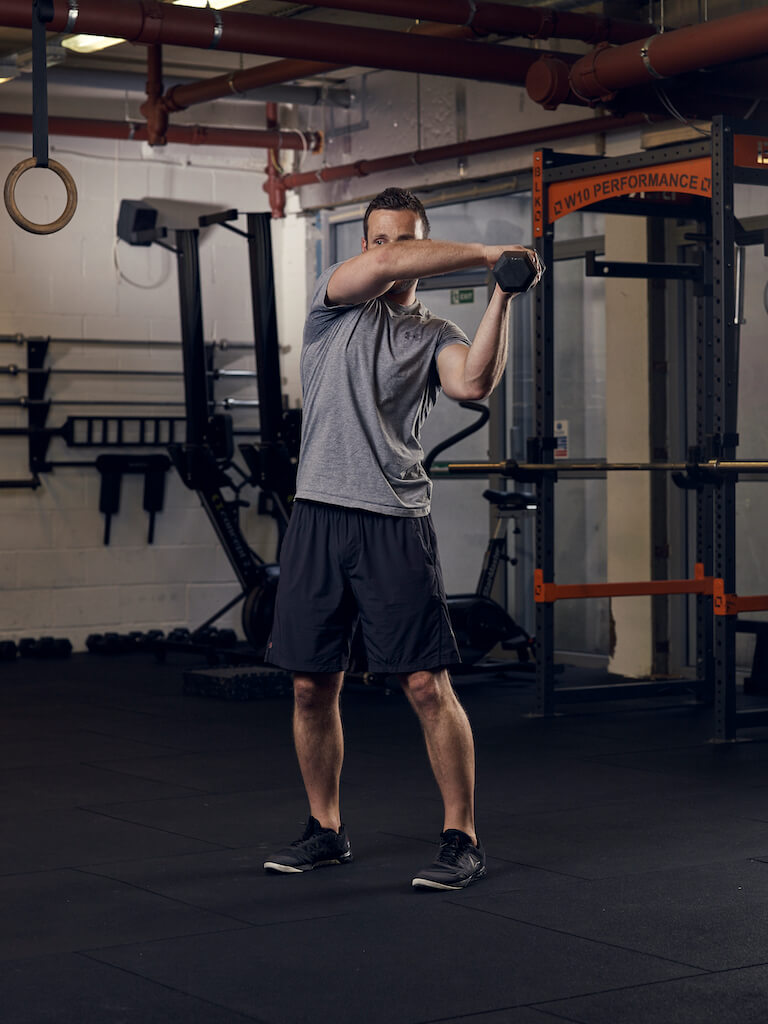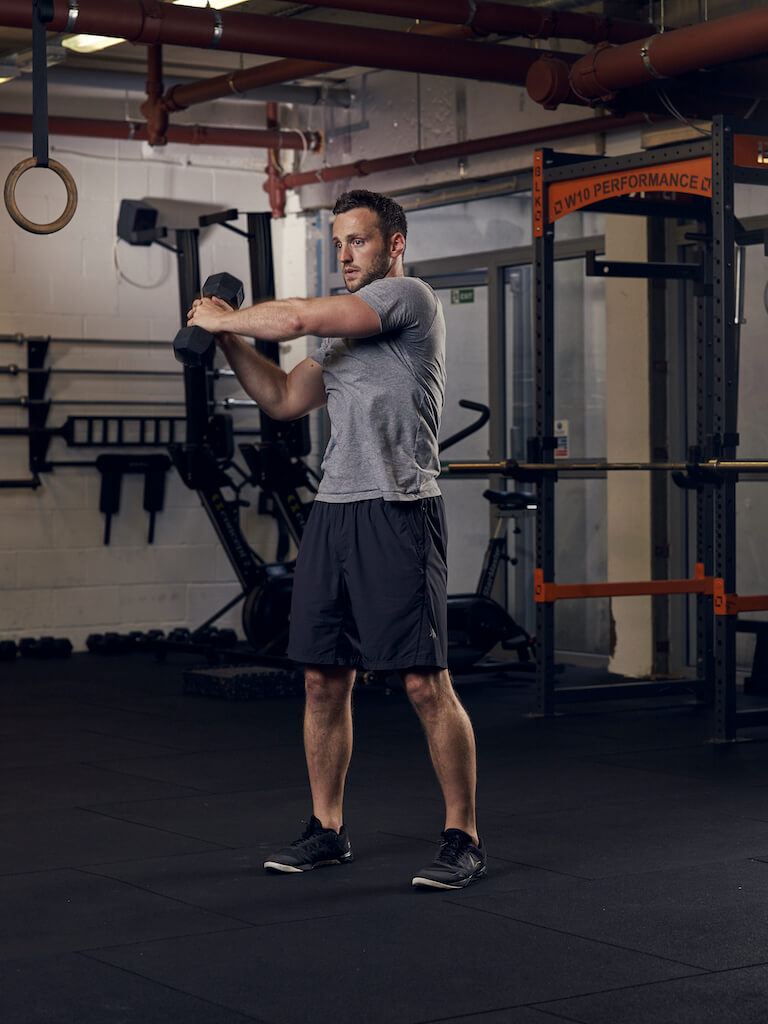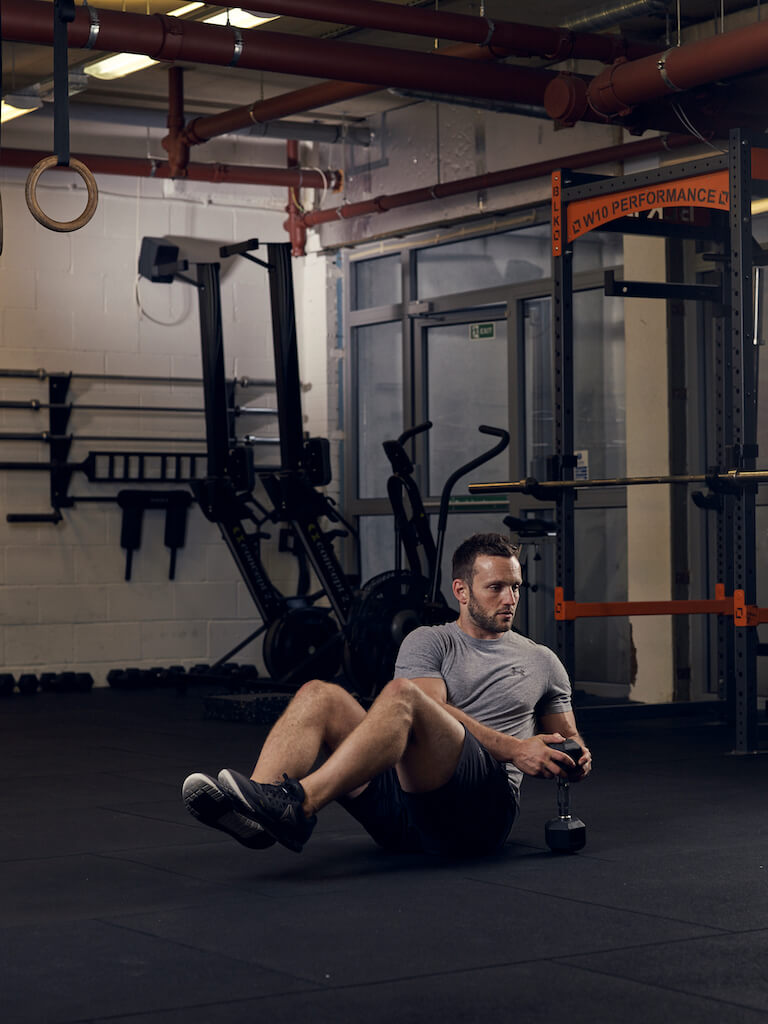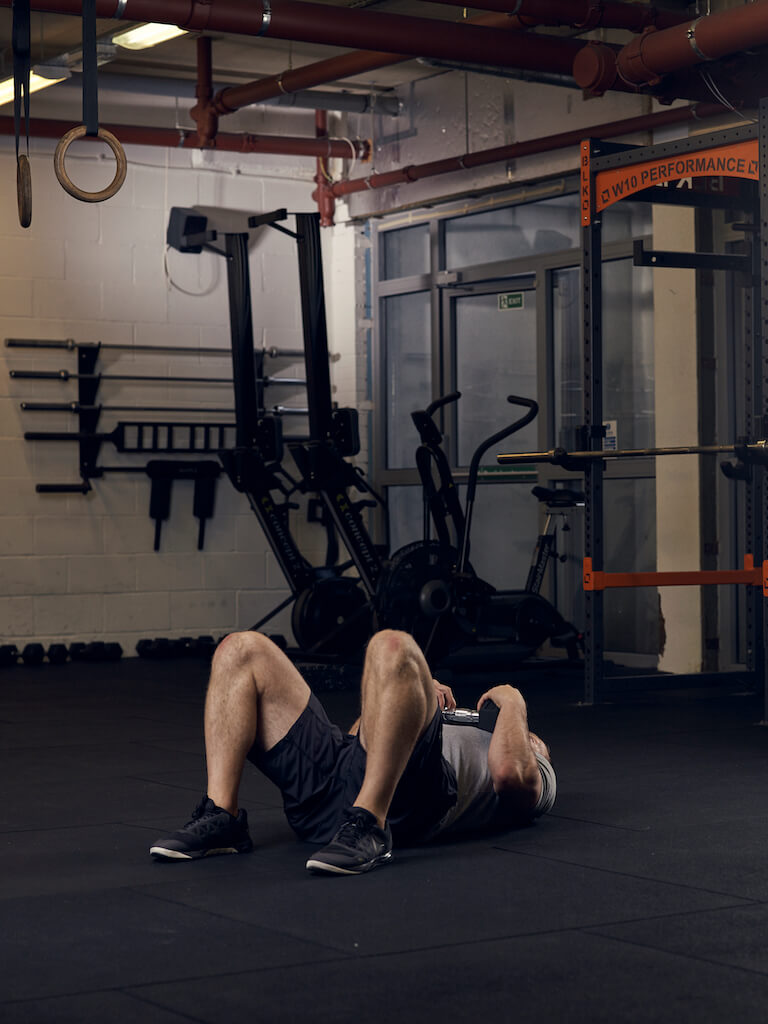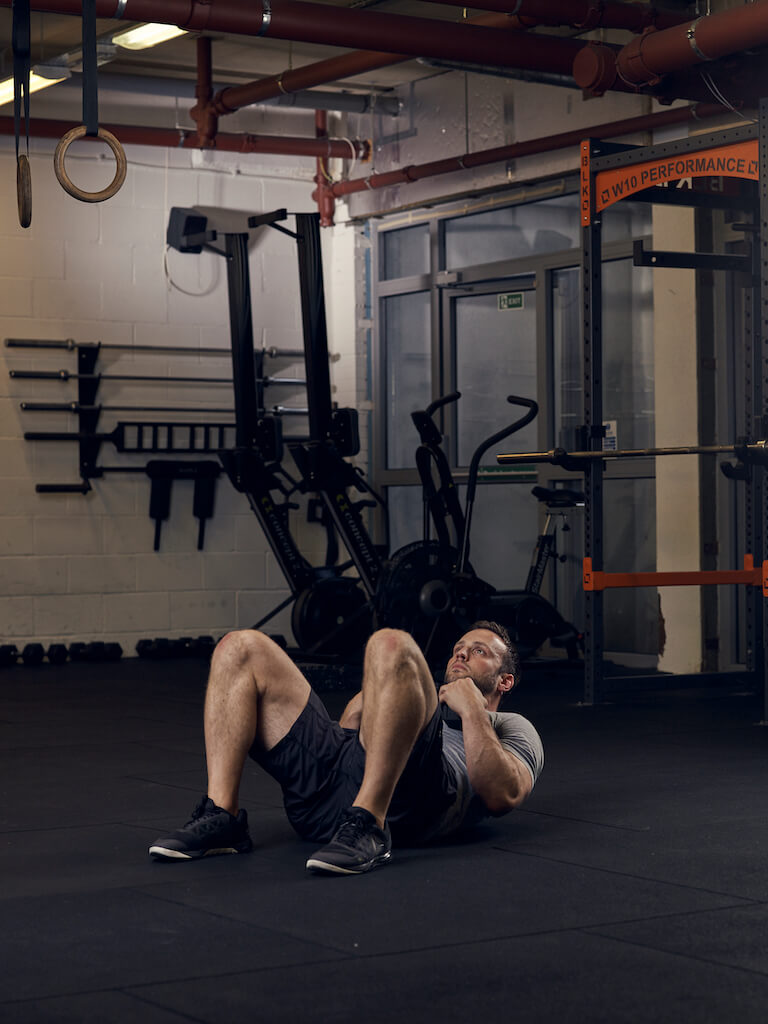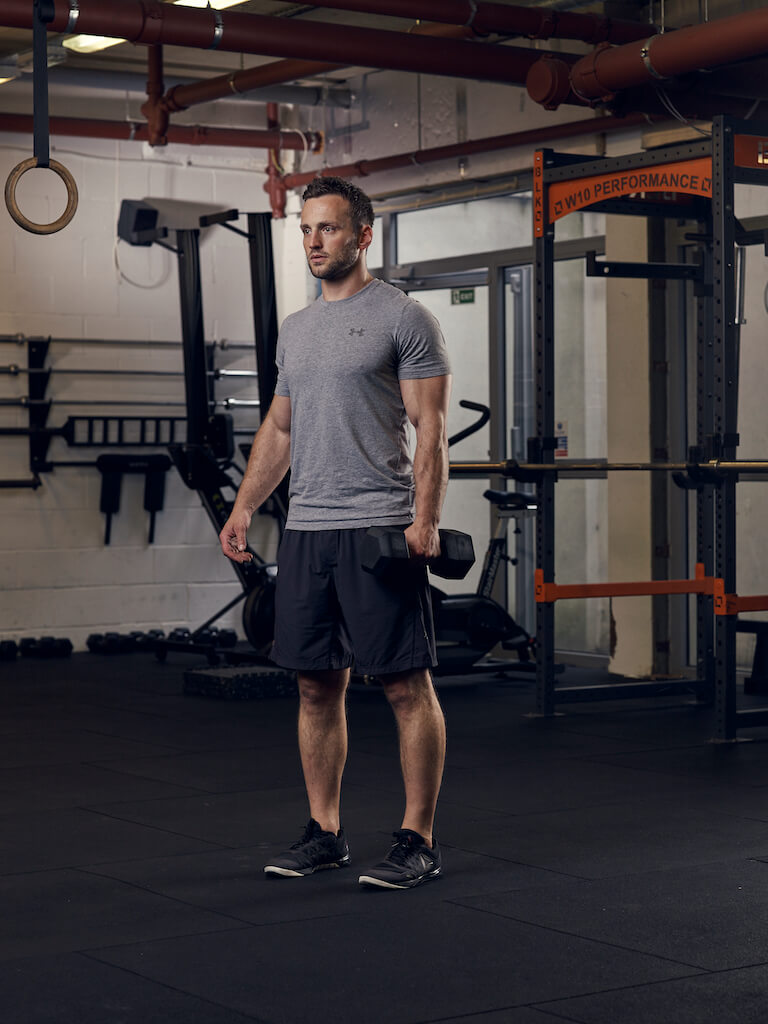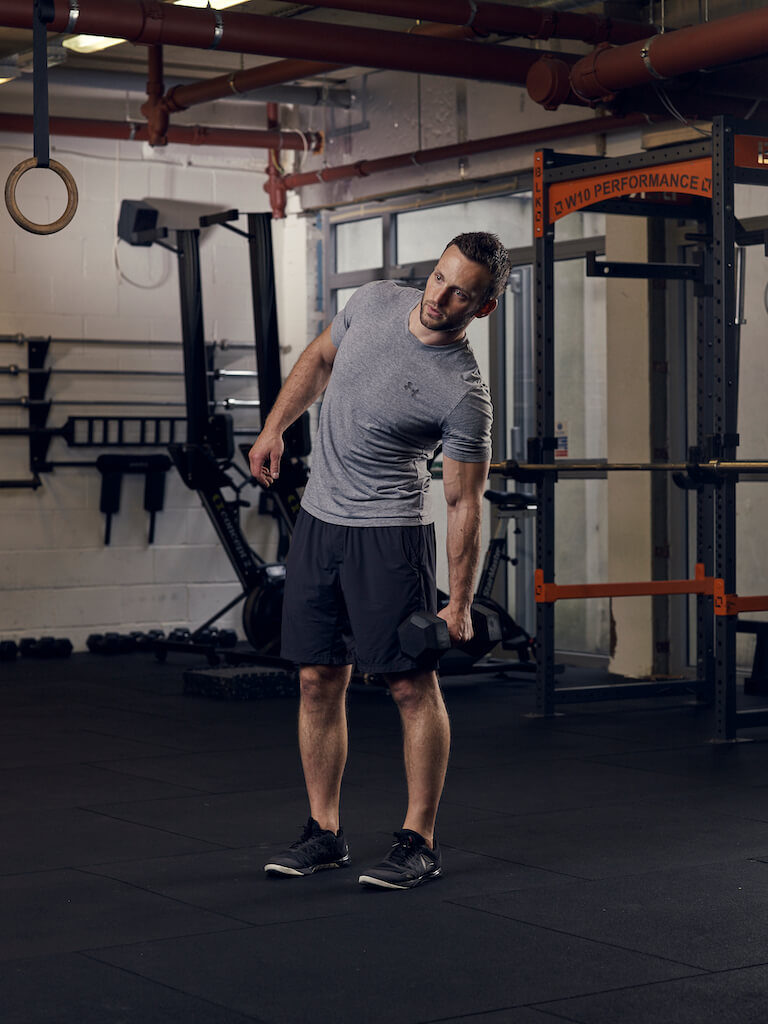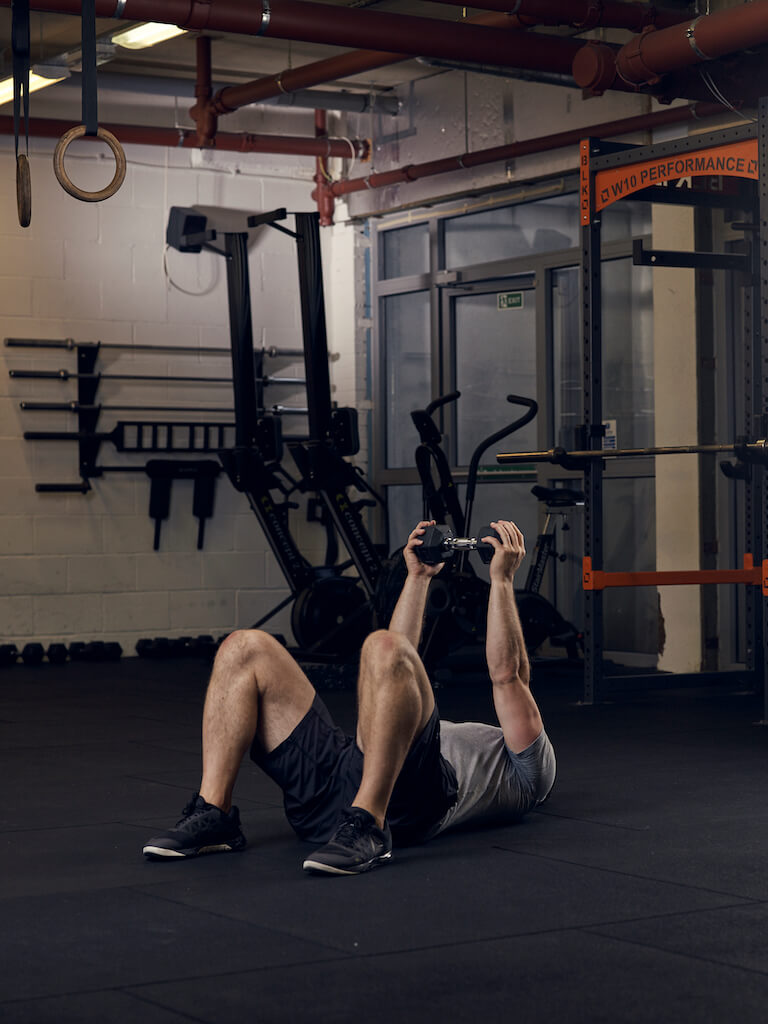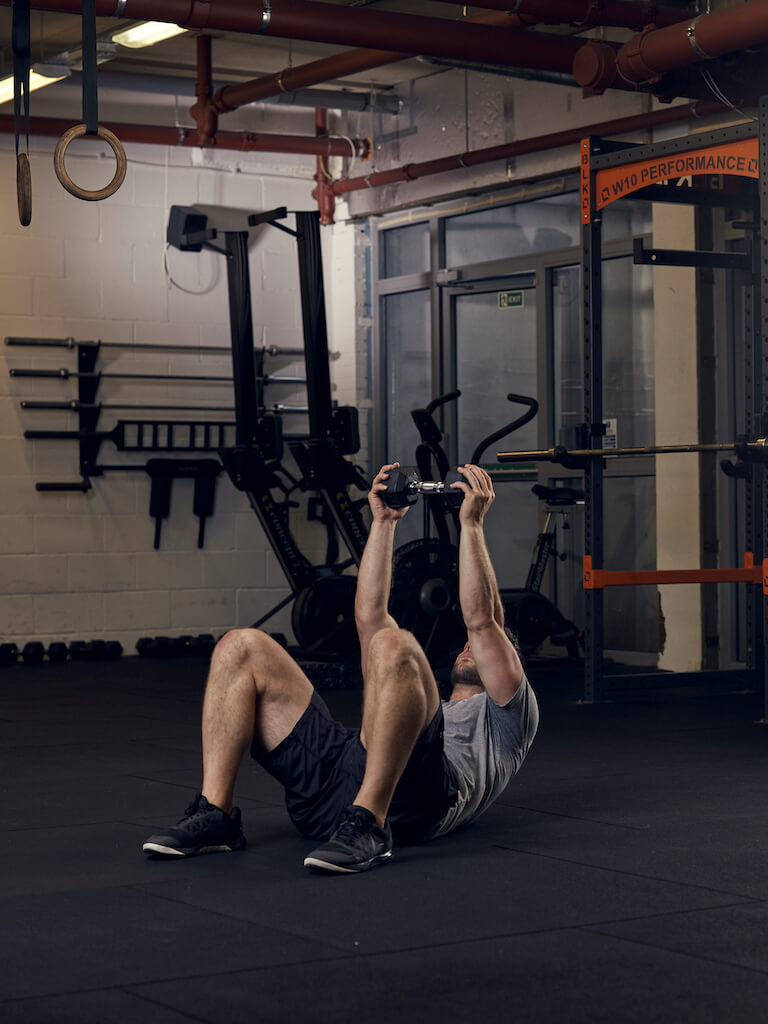Products You May Like
From shoulder presses to single-leg Romanian deadlifts, discover the best dumbbell exercises to add to your workouts for every body part, to build strength & muscle from home…
Need a pair of dumbbells? Discover our pick of the best dumbbells for home workouts
Simple, supremely effective and beginner-friendly, almost every man starts his fitness journey with a set of dumbbells – and for good reason. Small enough to tuck under a bed or sofa, dumbbells are easy to use and massively versatile, with a huge range of best exercises and workouts for every body part.
But that doesn’t mean they’re basic. For anyone with a bit of training knowledge, they offer much more than endless cheat curls.
By incorporating smart training techniques like tempo, time under tension or technical drop sets, you can use dumbbells to build just as much muscle as more fashionable fitness kit – and often more efficiently.
And, of course, if they’re tucked under your bed, you’re never far from your next workout.
Below, we’ve rounded up the best dumbbell exercises to add to your workouts to build strength and muscle…
Related: Best full-body dumbbell workout to try at home
Best dumbbell exercises for shoulder workouts
Sculpt strong shoulders with our selection of the best dumbbell exercises for your shoulder workouts…
- Dumbbell shoulder press
- Seated dumbbell shoulder press
- Seated dumbbell Arnold press
- Dumbbell lateral raise
- Dumbbell front raise
- Dumbbell reverse flye
- Alternating dumbbell press
- Cuban dumbbell press
Keep reading for full instructions on how to perform the best dumbbell exercises for shoulder workouts.
1. Dumbbell shoulder press
Benefits of the dumbbell shoulder press:
This classic shoulder-builder is slightly easier on your rotator cuffs (the small stabilising muscles around the shoulders) with a set of dumbbells, because your hands can rotate naturally. The ‘military’ version of this – done with your feet together, as if you were on parade – is slightly tougher on your core.
How to do the dumbbell shoulder press:
- With your feet shoulder-width apart, hold a dumbbell in each hand at shoulder height.
- Keep your chest upright and your core muscles braced.
- Press the weights directly upwards, keeping your core braced, until your arms are extended overhead.
- Lower and repeat.
2. Seated dumbbell shoulder press
Benefits of the seated dumbbell shoulder press:
The seated version of the overhead press takes your legs completely out of the equation, forcing you to keep the form strict and slightly reducing the focus on your core so your shoulders get more of a hit.
How to do the seated dumbbell shoulder press:
- Sit with your back against the upright part of a bench, holding a pair of dumbbells at your shoulders.
- Press them slowly overhead, allowing your arms to rotate naturally.
- Pause at the top, then lower under control.
3. Seated dumbbell Arnold press
Benefits of the seated dumbbell Arnold press:
This variation of the overhead press – popularised by the Governator himself – hits all three heads of the deltoids, adding thickness and width to your shoulders. It’ll also stabilise your shoulder joints for use in bigger lifts.
How to do the seated dumbbell Arnold press:
- Start at the top position of a biceps curl, with your elbows by your torso.
- Allow your palms to rotate as you press the dumbbells overhead, finishing with your palms facing forwards.
- Reverse the movement as you lower the dumbbells.
4. Dumbbell lateral raise
Benefits of the dumbbell lateral raise:
This isolation move shifts all the focus to your lateral deltoids, which move your arms away from your body. To make sure they’re working their hardest, angle your hands so your pinkies are slightly higher than your thumbs.
How to do the dumbbell lateral raise:
- Stand tall with your abs braced and feet close but not together, holding a light dumbbell in each hand by your sides with your palms facing one another.
- Keeping a slight bend in your elbows, raise the weights out to the sides making sure you use your muscles and not momentum.
- Stop just below shoulder height, then lower.
Read more: How to do a lateral raise: step-by-step form guide
5. Dumbbell front raise
Benefits of the dumbbell front raise:
This move targets the anterior deltoids, which is why many lifters use it in conjunction with the lateral raise to build bigger shoulders.
How to do the dumbbell front raise:
- Stand tall with your abs braced and feet apart, holding a light dumbbell in each hand by your sides with your palms facing one another.
- Keeping a slight bend in your elbows, raise the weights in front of you using your muscles and not momentum.
- Stop at shoulder height, pause for a second, then slowly return to the start.
6. Dumbbell reverse flye
Benefits of the dumbbell reverse flye:
This move targets your rear delts, while building stability through your shoulder region and rotator cuffs. Use it in tandem with lateral or front raises for a shoulder-building superset.
How to do the dumbbell reverse flye:
- Leaning forwards at the hips with a weight in each hand, keep your back flat and bring the weights upwards as if you were spreading your wings, aiming to bring your shoulder blades together at the top of the move.
7. Alternating dumbbell press
Benefits of the alternating dumbbell press:
This move targets your shoulders while also forcing your core to work as you stabilise the weight. Because you’re pressing one dumbbell at a time, you should also be able to handle slightly more weight in each hand.
How to do the alternating dumbbell press:
- Stand tall with your chest up and core braced, holding a pair of dumbbells at shoulder height.
- Press one overhead, pause and lower, then press the other.
8. Cuban dumbbell press
Benefits of the Cuban dumbbell press:
This move, which combines an upright row, external shoulder rotation and press, will strengthen your rotator cuffs, making you stronger and less injury-prone in other pressing variations. Do it for recovery on off days.
How to do the Cuban dumbbell press:
- Hold a light set of light dumbbells or weight plates by your sides, palms facing behind you.
- Raise your arms to the sides until your elbows are bent at 90° and the weights are hanging straight down.
- Keeping your upper arms horizontal, rotate your arms until your hands point up.
- Press the weights directly overhead.
- Reverse the movement back to the start.
Best dumbbell shoulder workouts:
TRY THIS: Dumbbell arm & shoulder workout to do at home
Best dumbbell exercises for chest workouts
Carve a stronger torso with our selection of the best dumbbell exercises for your chest workouts…
- Dumbbell bench press
- Dumbbell chest flye
- Incline dumbbell bench press
- Decline dumbbell bench press
Keep reading for full instructions on how to do the best dumbbell exercises for chest workouts.
9. Dumbbell bench press
Benefits of the dumbbell bench press:
Using dumbbells for this classic chest-builder emphasises your pecs more than the barbell version, because the dumbbells move slightly inwards throughout the rep and also go through a greater range of motion.
Benefits of the dumbbell bench press:
- Lie on a bench with your feet on the floor directly underneath your knees.
- Hold the dumbbells above your chest, then lower them to your chest.
- Drive your feet hard into the floor and push the dumbbells back strongly to the start position.
10. Dumbbell chest flye
Benefits of the dumbbell chest flye:
Because your pecs’ primary role is to move your arms inwards, this move puts much more emphasis on them than pressing variations, even though you’ll have to do it with much lighter weights. For best results, superset a press and a flye together.
How to do the dumbbell chest flye:
- Lie on a flat bench holding a dumbbell in each hand directly above your chest with your palms facing each other.
- Keeping a slight bend in your elbows, slowly lower the weights to the sides as far as is comfortable, feeling the stretch in your chest.
- Squeeze your chest to reverse the movement and raise the weights back to the top.
11. Incline dumbbell bench press
Benefits of the incline dumbbell bench press:
This variation of the flat bench puts less stress on the pecs and rotator cuffs. It’ll also give your shoulders some work.
How to do the incline dumbbell bench press:
- Lie on a bench set at an angle holding a dumbbell in each hand at chest level.
- Keep your feet flat on the floor and your back against the bench.
- Press the weight directly above your head but don’t lock out your elbows at the top.
- Slowly lower the weights back to chest level.
12. Decline dumbbell bench press
Benefits of the decline dumbbell bench press:
This bench variation targets your lower chest better than other versions, which will help to fix imbalances and build a well-rounded chest. It also takes your shoulders out of the equation, putting more emphasis on your chest.
How to do the decline dumbbell bench press:
- Lie on a bench set at an angle – if your gym doesn’t have a decline bench, prop a weight plate under a regular bench – holding a dumbbell in each hand at chest-level.
- Keep your feet flat on the floor and your back against the bench.
- Press the weight directly above your head but don’t lock out your elbows at the top.
- Slowly lower the weights back to chest level.
Best dumbbell chest workouts:
TRY THIS: Dumbbell chest & core workout
Best dumbbell exercises for back workouts
For detailed instructions on each of the below plus nine other exercises, read our best dumbbell exercises for back
13. Dumbbell bent-over row
14. Reverse-grip dumbbell bent-over row
15. Dumbbell single-arm row
16. Dumbbell shrug
Best dumbbell exercises for arm workouts
Strengthen your biceps, triceps and forearms with our pick of the best dumbbell exercises for your arm workouts…
- Dumbbell biceps curl
- Alternating dumbbell biceps curl
- Dumbbell hammer curl
- Alternating dumbbell hammer curl
- Dumbbell zottman curl
- Dumbbell incline biceps curl
- Dumbbell triceps extension
- Single-arm dumbbell triceps extension
Keep reading for full instructions on how to perform the best dumbbell exercises for arm workouts.
17. Dumbbell biceps curl
Benefits of the dumbbell biceps curl:
It’s the classic. Done correctly, a slow, controlled biceps curl is one of the best ways to put your biceps under the extended tension needed for growth. For best results, don’t let the tension off your muscles at any point during the move.
How to do the dumbbell biceps curl:
- Stand tall with your shoulders back and feet close together, holding a pair of dumbbells with palms facing forwards and hands just outside your hips.
- Keeping your elbows tucked in to your sides, curl the dumbbells up towards your chest, stopping just before your forearms reach vertical.
- Lower under control to return to the start position.
18. Alternating dumbbell biceps curl
Benefits of the alternating dumbbell biceps curl:
Done at the end of a set of biceps curls, these can let you squeeze out a few extra reps, increasing the damage to the muscle and the growth you’ll see afterwards. Using them on their own is less advisable because they’ll give your biceps too long to rest between reps.
How to do the alternating dumbbell biceps curl:
- Stand tall with your shoulders back and feet close together, holding a pair of dumbbells with your palms facing forwards.
- Keeping your elbows tucked in to your sides, curl one dumbbell up towards your chest, then lower it and raise the other.
19. Dumbbell hammer curl
Benefits of the dumbbell hammer curl:
Though it works similar muscles to the biceps curl, the hammer curl puts extra emphasis on the brachioradialis, which pushes up on your biceps to make the muscles appear bigger. They’ll also work well in combination with biceps curls for a technical drop set that takes your biceps past failure.
How to do the dumbbell hammer curl:
- Stand tall with your shoulders back and feet close together, holding a pair of dumbbells with your palms facing your sides.
- Keeping your elbows tucked in to your sides, curl the dumbbells up towards your chest, stopping just before your forearms reach vertical.
- Lower under control to return to the start position.
20. Alternating dumbbell hammer curl
Benefits of the alternating dumbbell hammer curl:
Done at the end of a set of biceps or hammer curls, these can let you squeeze out a few extra reps, increasing the damage to the muscle and the growth you’ll see afterwards. For a triple drop set, go to failure on first biceps curls then hammer curls, and finish with alternating hammer curls.
How to do the alternating dumbbell hammer curl:
- Stand tall with your shoulders back and feet close together, holding a pair of dumbbells with your palms facing your sides.
- Keeping your elbows tucked in to your sides, curl one dumbbell up towards your chest, then lower it and raise the other.
21. Dumbbell zottman curl
Benefits of the dumbbell zottman curl:
This move targets all the muscles on the front of your upper arm in every rep, using both heads of the biceps – brachii and brachialis – on the way up, and the brachioradialis when you go palms-down for the descent. The twist also adds some extra stimulation for an all-around arm builder.
How to do the dumbbell zottman curl:
- Hold a dumbbell in each arm and curl them up to chest height, then twist your palms to face downwards before you lower, shifting the focus to your forearms.
22. Dumbbell incline biceps curl
Benefits of the dumbbell incline biceps curl:
This move puts more emphasis on the biceps brachii, which is the largest and most visible of the biceps muscles. You’ll probably need to use less weight than you would on the standing curl, but it’s worth the effort.
How to do the dumbbell incline biceps curl:
- Sit on a bench set to an incline between 30˚ and 45˚ holding a dumbbell in each hand.
- Keeping your back flat against the bench and your elbows close to your sides, curl both dumbbells up to shoulder height.
- Squeeze your biceps at the top of the move, then slowly return the start.
23. Dumbbell triceps extension
Benefits of the dumbbell triceps extension:
As well as working the largest muscle in your arms, the standing triceps extension forces your core to stabilise you, giving you some extra six-pack work as you lift.
How to do the dumbbell triceps extension:
- Stand tall, holding a pair of dumbbells above you with straight arms.
- Slowly lower the dumbbells towards the back of your head by bending your elbows, keeping your upper arms as still as possible.
24. Single-arm dumbbell triceps extension
Benefits of the single-arm dumbbell triceps extension:
Used as part of a drop set, the one-arm triceps extension puts your triceps under extra tension, forcing further growth.
How to do the single-arm dumbbell triceps extension:
- Stand tall, holding a dumbbell above you with one straight arm.
- Slowly lower the dumbbell towards the back of your head by bending your elbow, keeping your upper arm as still as possible.
Best dumbbell arm workouts:
TRY THIS: Build bigger arms at home with this dumbbell workout
Best dumbbell exercises for leg workouts
Plan your next leg day with our selection of the best dumbbell exercises for your lower-body workouts…
- Dumbbell squat
- Overhead dumbbell squat
- Dumbbell goblet squat
- Dumbbell jump squat
- Dumbbell lunge
- Reverse dumbbell lunge
- Dumbbell side lunge
- Dumbbell split squat
- Dumbbell jumping lunge
- Dumbbell Romanian deadlift
- Single-leg dumbbell Romanian deadlift
Keep reading for full instructions on how to perform the best dumbbell exercises for leg workouts.
25. Dumbbell squat
Benefits of the dumbbell squat:
As well as being ideal for home workouts, the dumbbell squat keeps the weights in a back-friendly position, making it (almost) fatigue-proof. It’ll also work your forearms and grip.
How to do the dumbbell squat:
- Hold a dumbbell in each hand and squat down, keeping your chest up, until your hip crease is below the level of your knees.
- Drive back up through your heels.
26. Overhead dumbbell squat
Benefits of the overhead dumbbell squat:
It’s upper- and lower-body flexibility rolled into one move, and much tougher than the barbell version because the weights tend to wander. If all you’ve got is a brace of ultra-light dumbbells, try staying in the bottom position for a set of overhead presses – known as the ‘Sots press’.
How to do the overhead dumbbell squat:
- Press a set of dumbbells overhead, keeping your upper arms just behind the line of your ears and over your centre of gravity.
- Keep your weight over your heels as you squat down and drive back up, trying not to let the weights stray forward.
27. Dumbbell goblet squat
Benefits of the dumbbell goblet squat:
It’s a near-foolproof squat variation: the position of the dumbbell forces you to keep your chest up and your weight on your heels. If you’ve got hip, groin or ankle mobility issues, spend some time in the bottom position during your warm-up for a helpful weighted stretch.
How to do the dumbbell goblet squat:
- Hold a dumbbell at chest height with both hands – like a goblet – then squat down until your elbows brush the insides of your knees.
- Keep your weight on your heels as you stand up.
28. Dumbbell jump squat
Benefits of the dumbbell jump squat:
Holding a pair of dumbbells is the simplest way to add weight to a jump squat, so this variation will let you add power once you’ve topped out on the no-weight version.
How to do the dumbbell goblet squat:
- Holding a dumbbell in each hand, squat down, then explode upwards, aiming to get as much height as possible.
- Reset between reps for maximum power generation.
29. Dumbbell lunge
Benefits of the dumbbell lunge:
Working one leg at a time builds unilateral strength and also ensures you don’t have any weaknesses from imbalances in your body. If you’re limited by your grip, hold the dumbbell in front of your chest, goblet-squat style.
How to do the dumbbell lunge:
- Holding a dumbbell in each hand, take one step forwards and lower your body until both knees are bent at 90˚.
- Push off your front foot to reverse the movement.
30. Reverse dumbbell lunge
Benefits of the reverse dumbbell lunge:
Stepping backwards instead of forwards shifts the emphasis to your glutes, but also makes the lunge slightly safer, because it’s easier to stop your front knee from wobbling off-line. If you’re fatigued, do these: you’ll still get a forearm hit from holding the dumbbells.
How to do the reverse dumbbell lunge:
- Holding a dumbbell in each hand, take a big step backwards and lower your body until both knees are bent at 90˚.
- Push off your rear foot to reverse the movement.
31. Dumbbell side lunge
Benefits of the dumbbell side lunge:
This move’s tricky to do with anything but dumbbells, but it works the inner and outer thighs as well as the usual muscles involved in the lunge, so it’s well worth including in your training plan.
How to do the dumbbell side lunge:
- Holding a dumbbell in each hand, take one step sideways and lower your body until one of your knees is bent at a right angle, feeling a slight stretch in your groin.
- Push off your foot to reverse the movement.
32. Dumbbell split squat
Benefits of the dumbbell split squat:
Simply repeating the lunge motion removes some of the coordination aspects from a heavy lunge, making this a safer variation for beginners or including in supersets where you’re likely to be fatigued.
How to do the dumbbell split squat:
- Start in a split stance, with one foot in front of the other, holding a dumbbell in each hand.
- Bend both legs until your trailing knee touches the floor.
- Straighten both legs to return to the start, then go straight into the next rep.
33. Dumbbell jumping lunge
Benefits of the dumbbell jumping lunge:
It’s tough with dumbbells, but the lunge jump will build explosive power off one leg – essential for sprinting or tackling.
How to do the dumbbell jumping lunge:
- Stand tall holding a dumbbell in each hand.
- Lunge forward, then explode into the air, switching legs in mid-air and aiming to land softly.
34. Dumbbell Romanian deadlift
Benefits of the dumbbell Romanian deadlift:
This deadlift variation shifts the emphasis to your hamstrings, making it an ideal accessory exercise to the normal deadlift. Doing it with dumbbells will ensure each arm gets to hold its share of the weight.
How to do the dumbbell Romanian deadlift:
- Stand tall with feet shoulder-width apart, holding a dumbbell in each hand.
- Keeping your legs straight, lean forward from the hips, not the waist, and lower the weights down the fronts of your shins until you feel a good stretch in your hamstrings.
- Reverse the move to the start and push your hips forward.
35. Single-leg dumbbell Romanian deadlift
Benefits of the single-leg dumbbell Romanian deadlift:
This move challenges your balance and proprioception while firing up your hamstrings, making it the ideal warm-up for conventional deadlifting.
How to do the single-leg dumbbell Romanian deadlift:
- Stand on one leg, holding a dumbbell in the opposite hand.
- Bend forward until you feel the stretch in your hamstrings, then straighten up.
Best dumbbell leg workouts:
TRY THIS: Dumbbell-only leg workout
Best dumbbell exercises for core workouts
Target your abs with our pick of the best dumbbell exercises for your core workouts…
- Dumbbell renegade row
- Dumbbell press-up to renegade row
- Dumbbell halo
- Dumbbell Russian twist
- Dumbbell crunch
- Dumbbell side bend
- Dumbbell crunch reach
Keep reading for full instructions on how to perform the best dumbbell exercises for core workouts.
36. Dumbbell renegade row
Benefits of the dumbbell renegade row:
This move works your back muscles while challenging your stabilisers to keep you level. Think of it as a brutal version of the plank. It’s even tougher on rounded dumbbells.
How to do the dumbbell renegade row:
- Start in a press-up position holding the handles of a pair of dumbbells.
- Row one dumbbell upwards and then the other, so that your thumb touches your armpit.
- Try to stay parallel to the floor – don’t twist.
37. Dumbbell press-up to renegade row
Benefits of the dumbbell press-up to renegade row:
Adding a press-up to the move engages your chest – especially if you use the extra height to descend further into the move. It’s pulling and pushing in one move, making this great bang for your buck.
How to do the dumbbell press-up to renegade row:
- Start in a press-up position holding the handles of a pair of dumbbells.
- Do a press-up.
- At the top of the move, row one dumbbell upwards and then the other, so that your thumb touches your armpit.
- Try to stay parallel to the floor – don’t twist.
38. Dumbbell halo
Benefits of the dumbbell halo:
This move engages all the muscles of your core and, because you’re doing it from a standing position, teaches them to fire in practical situations.
How to do the dumbbell halo:
- Holding a dumbbell in both hands, move it around your head, engaging your core as you circle it around.
- After one complete circle, reverse directions.
39. Dumbbell Russian twist
Benefits of the dumbbell Russian twist:
Training rotation is vital for sports performance and a well-rounded physique, and this is one of the safest ways to do it effectively.
How to do the dumbbell Russian twist:
- Sit on the floor with your knees bent and feet slightly raised, holding a dumbbell in front of you.
- Twist to one side, pause, and then twist to the other.
- That’s one rep.
40. Dumbbell crunch
Benefits of the dumbbell crunch:
In lab testing, weighted crunches activate the abs more than almost any other isolation move. Using a dumbbell (or weight plate) for slow, controlled reps is a great way to work your whole core.
How to do the dumbbell crunch:
- Lie flat on your back with knees bent and a dumbbell held at chest level.
- Contract your abs to lift your shoulders off the floor and curl your chest towards your knees.
- Pause at the top of the move and squeeze your abs, then lower slowly to the start.
41. Dumbbell side bend
Benefits of the dumbbell side bend:
As well as your obliques the side bend also works the muscles of your lower back, safeguarding your core.
How to do the dumbbell side bend:
- Hold a heavy dumbbell in one hand and bend your torso towards your weighted hand.
- Pause when you feel a stretch up your opposite side, then straighten up without leaning forwards or back.
42. Dumbbell crunch reach
Benefits of the dumbbell crunch reach:
Leading with the dumbbell discourages you from jerking, ensuring that the focus stays on your abs while safeguarding your lower back.
How to do the dumbbell crunch reach:
- Lie flat on your back with your knees bent and a dumbbell held above your chest with arms straight.
- Crunch upward, pausing at the top of the movement, then lower back to the start.
Best dumbbell core workouts:
TRY THIS: Dumbbell chest & core workout
Photography: Glen Burrows
RELATED CONTENT:
- Best Full Body Dumbbell Workout To Try At Home
- Best Resistance Band Workouts & Exercises For Men
- Home Dumbbell HIIT Workout For Full Body Burn

